Ad-free. Influence-free. Powered by consumers.
The payment for your account couldn't be processed or you've canceled your account with us.
We don’t recognize that sign in. Your username maybe be your email address. Passwords are 6-20 characters with at least one number and letter.
We still don’t recognize that sign in. Retrieve your username. Reset your password.
Forgot your username or password ?
Don’t have an account?
- Account Settings
- My Benefits
- My Products
- Donate Donate
Save products you love, products you own and much more!
Other Membership Benefits:
Suggested Searches
- Become a Member
Car Ratings & Reviews
2024 Top Picks
Car Buying & Pricing
Which Car Brands Make the Best Vehicles?
Tires, Maintenance & Repair
Car Reliability Guide
Key Topics & News
Listen to the Talking Cars Podcast
Home & Garden
Bed & Bath
Top Picks From CR
Best Mattresses
Lawn & Garden
TOP PICKS FROM CR
Best Lawn Mowers and Tractors
Home Improvement
Home Improvement Essential
Best Wood Stains
Home Safety & Security
HOME SAFETY
Best DIY Home Security Systems
REPAIR OR REPLACE?
What to Do With a Broken Appliance
Small Appliances
Best Small Kitchen Appliances
Laundry & Cleaning
Best Washing Machines
Heating, Cooling & Air
Most Reliable Central Air-Conditioning Systems
Electronics
Home Entertainment
FIND YOUR NEW TV
Home Office
Cheapest Printers for Ink Costs
Smartphones & Wearables
BEST SMARTPHONES
Find the Right Phone for You
Digital Security & Privacy
MEMBER BENEFIT
CR Security Planner
Take Action

Guide to Adaptive Cruise Control
How this convenience feature works to reduce your stress on long drives
Adaptive cruise control (ACC) is like traditional cruise control, but smarter. ACC systems allow you to set a desired speed until your vehicle encounters slower-moving traffic. Then it will brake to maintain a set distance from the car ahead. Once the traffic starts moving again or if there is no longer a car in the lane ahead, ACC will accelerate to resume the previous set speed. Although ACC systems may take some getting used to, our survey respondents told us they appreciated the stress relief the feature brings.
“I use the feature mostly on the freeway and in stop-and-go traffic. I find it reduces tension and fatigue,” wrote a 2020 Subaru Outback owner. A 2018 Audi Q5 driver agreed. “It is so nice to just set it and let the car worry about the traffic,” they told CR.
The systems use lasers, radar, cameras, or a combination of those. If traffic slows to a stop, most ACC systems will bring the car to a complete stop, then bring it back up to speed when traffic gets going again. Others work only within certain speeds and/or might not start to accelerate automatically.
Adaptive cruise control (ACC): Cruise control that also assists with acceleration and/or braking to maintain a driver-selected gap to the vehicle in front. Some systems can come to a stop and continue while others cannot. If the car comes to a full stop, you may have to press the accelerator or a button on the steering wheel to start moving again.
Not all systems work at low speeds, so drivers who plan to use ACC in slow traffic should check the limitations of any system they plan to buy. These particular systems will often have the words “traffic jam” or “stop and go” in their name.
These features are usually activated using a button on the steering wheel with the image of a car next to a speedometer with an arrow pointing at it. A conventional cruise control system does not automatically keep a set distance away from the car in front, and it is indicated by a similar logo without the car next to the speedometer. A tip to know if your car has adaptive cruise control or regular cruise control is to look for the “gap distance” button, which usually shows a symbol of a car with horizontal distance bars in front. This button will determine how much space your car leaves between its front bumper and the rear of the car it is following.
In our most recent survey, we asked CR members to rate their experiences with the advanced safety and driver assistance systems on their model-year 2017 to 2022 cars. Respondents answered questions about their satisfaction with the systems. The survey covered about 47,000 vehicles. Most respondents told us they were “very satisfied” with ACC. Satisfaction was higher for older drivers.
OVERALL SATISFACTION
What to Look For in an Adaptive Cruise Control System
Every ACC system works slightly differently, says Kelly Funkhouser, manager for vehicle technology at CR. Some do a better job than others at recognizing merging traffic and automatically apply the brakes, while others wait too long to slow your car, requiring the driver to take control—especially when a vehicle in front of you cuts you off with a close merge.
“Most ACC systems can only be set to speeds above 20 mph but will slow the vehicle to speeds below that in stop-and-go traffic,” she says. “There are a few systems out there that don’t bring the car all the way to a stop but instead just shut off at low speeds. That can be dangerous when you’re traveling behind another slowing vehicle.” She recommends reading the automaker’s website closely and learning about the speed ranges before using ACC while on your test drive.
ACC is meant for convenience, not as a replacement for an alert driver, Funkhouser says. So don’t use adaptive cruise control as an excuse to get distracted. “Just because the car is controlling your speed doesn’t mean that you can check out,” she says. “These systems do not do well at detecting or slowing for vehicles ahead if you approach them at a high rate of speed. The driver should always be monitoring the surrounding traffic and looking ahead for potential hazards.”
Keith Barry
Keith Barry has been an auto reporter at Consumer Reports since 2018. He focuses on safety, technology, and the environmental impact of cars. Previously, he led home and appliance coverage at Reviewed; reported on cars for USA Today, Wired, and Car & Driver; and wrote for other publications as well. Keith earned a master’s degree in public health from Tufts University. Follow him on Twitter @itskeithbarry .
Sharing is Nice
We respect your privacy . All email addresses you provide will be used just for sending this story.
Trending in Car Safety
Best Labor Day Deals on New Cars for 2024
Popular Cars to Avoid and What to Buy Instead
Best Cars of the Year: 10 Top Picks of 2024
Best Used Cars and SUVs Under $20,000
- Credit cards
- View all credit cards
- Banking guide
- Loans guide
- Insurance guide
- Personal finance
- View all personal finance
- Small business
- Small business guide
- View all taxes
You’re our first priority. Every time.
We believe everyone should be able to make financial decisions with confidence. And while our site doesn’t feature every company or financial product available on the market, we’re proud that the guidance we offer, the information we provide and the tools we create are objective, independent, straightforward — and free.
So how do we make money? Our partners compensate us. This may influence which products we review and write about (and where those products appear on the site), but it in no way affects our recommendations or advice, which are grounded in thousands of hours of research. Our partners cannot pay us to guarantee favorable reviews of their products or services. Here is a list of our partners .
What Is Adaptive Cruise Control?

Many, or all, of the products featured on this page are from our advertising partners who compensate us when you take certain actions on our website or click to take an action on their website. However, this does not influence our evaluations. Our opinions are our own. Here is a list of our partners and here's how we make money .
Adaptive cruise control (ACC) is similar to standard cruise control in that it maintains a driver's preset speed once engaged. But unlike basic cruise control, ACC also automatically adjusts a car's speed based on traffic conditions.
For example, if the car in front of you slows, the system will automatically engage the car’s brakes to slow your speed and maintain a safe distance between you and the car ahead. Once the car in front of you speeds up, the system will resume the set speed.
While not federally mandated, most new cars come with ACC technology.
ACC is an advanced-driver assistance system, or ADAS. ADAS use in-vehicle technological features to help increase safety while driving. Other ADAS technologies include antilock brakes, lane departure warning and forward collision warning, among others. Some ADAS technologies are paired together in some newer vehicles, but this isn't always the case.
» MORE: Car safety features: What you need to know
How does adaptive cruise control work?
ACC systems use cameras, sensors and radar technology — or a combination of the three — to monitor the distance between your car and the car in front of you. This technology also automatically accelerates or slows your car, based on your settings and the speed limit.
You can set your speed and following distance, or how much space you want between the car in front of you and your car, with controls typically located on the steering wheel. ACC systems automatically keep your car at the preset speed and distance unless traffic ahead slows or you brake. You can reset your speed and distance at any time while driving.
What to know about adaptive cruise control
Adaptive cruise control systems are also often referred to as active cruise control, dynamic cruise control, radar cruise control and intelligent cruise control, among other names. And like its names, the specifics of how the system functions can also vary between vehicle makes and models.
For example, most ACC systems can bring your car to a complete stop if traffic around you stops, then accelerate once traffic picks up again. Other systems, however, don't have this capability or may not work below certain speeds.
Some ACC systems can anticipate curves and adjust a car’s speed when it's approaching a curve. However, some ACC systems may not be able to anticipate traffic on curving roads as well as they would on straight ones, and therefore may not be able to adjust a car’s speed accordingly.
Like similar advanced safety features that use cameras and sensors, ACC functionality can be affected by weather conditions like rain or snow, which means that drivers should remain vigilant even when the system is activated.
Popular Searches
SUBARU STARLINK In-Vehicle Technology
Eyesight Driver Assist Technology
Parts and Accessories
Helpful Links
Customer Service
Vehicle Recalls
All Vehicles
Special Offers
Local Inventory
Our Company
Meet the Subaru Family
What is adaptive cruise control (acc).
Adaptive Cruise Control (ACC) is an intelligent driver assistance feature that works as an enhancement to traditional cruise control. Using a system of advanced sensors such as radar and cameras, ACC determines the speed and conditions of surrounding traffic and automatically adjusts cruising speed to maintain a safe distance within the flow of traffic. Many ACC systems can also recognize sudden changes in traffic conditions and alert the driver to take action to prevent a crash.
Depending on vehicle manufacturer and the system itself, any number of other terms might be used interchangeably with Adaptive Cruise Control, including:
- Active Cruise Control
- Dynamic Cruise Control
- Automatic Cruise Control
- Intelligent Cruise Control
- Smart Cruise Control
- Radar Cruise Control
How does Adaptive Cruise Control Work?
ACC uses a set of intelligent sensors including radar, lidar, lasers, GPS, and cameras. These sensors are placed around a vehicle’s exterior to monitor the road and nearby vehicles. Gathering real-time data on the distance away and speed of the vehicle in front, these sensors allow the ACC system to adjust the car’s speed as-needed. Typically, the driver sets their desired cruising speed when they engage ACC on the highway. The system then automatically accelerates and decelerates to stay at a safe distance from other cars within the flow of traffic.
Much like using traditional cruise control, activating ACC is intentionally simple so that a driver can easily use it while keeping their eyes safely on the road. Generally, the dedicated ACC button or switch is located on the steering wheel or control panel. Pressing or toggling this mechanism allows the driver to set their initial cruising speed. In some systems, drivers can also set their desired following distance.
While operating, certain ACC systems can take extra measures for safety and convenience purposes:
- Maintaining a particular distance from vehicles ahead
- Making complete stops in traffic and restarting from a complete stop when traffic resumes
- Remaining engaged at low speeds in city traffic
- Anticipating and automatically slowing around upcoming curves
- Adjusting to posted speed limits as they change
Once in operation, the ACC system remains working until the driver disengages by either pressing the brake pedal or manually deactivating the system using the dedicated switch or button. Sometimes, ACC will use visual and audio cues to alert the driver to brake if it detects a possible collision ahead. In these instances, the driver must then re-engage the system once traffic resumes.
Benefits of Adaptive Cruise Control
Some of the benefits of adaptive cruise control include creating a more relaxed driving experience, particularly during long road trips and on highways, thanks to the system’s ability to adjust automatically to traffic speed variations and road conditions. Additionally, ACC encourages safe driving practices and helps reduce crash risk by monitoring following distance and alerting the driver or intervening if a vehicle is quickly approaching. Drivers using ACC may also see improved fuel efficiency, especially on the highway, since the system helps maintain an even speed and reduces unnecessary acceleration and braking.
Advanced Adaptive Cruise Control in Subaru Vehicles
The Subaru application of ACC is known as Advanced Adaptive Cruise Control. This feature functions seamlessly as part of our EyeSight ® Driver Assist technology —a comprehensive suite of safety features designed to enhance the driving experience. Nearly all Subaru models and trims come standard with EyeSight and Advanced Adaptive Cruise Control, including some of our most popular models like the Outback , Forester , Crosstrek , and Impreza . EyeSight is an available feature on our performance sports models with automatic transmissions, including the WRX and the BRZ , as well as those with manual transmissions.
Complementing its active cruise control functionality, EyeSight includes additional advanced features including Pre-Collision Braking and Throttle Management, Automatic Emergency Steering, Lane Centering, and Lane Departure Assist designed to help keep drivers safer. In particular, Lane Departure Assist and Lane Centering monitor lane markings and can help assist drivers with steering to avoid accidental drifting into another lane. The advanced ACC sensors can also recognize another driver approaching and adjust your vehicle’s placement within the lane to create a safer distance on all sides.
Read more about our EyeSight technology.
Discover the Safety and Convenience of Subaru EyeSight Driver Assist Technology. Visit Us to Experience it in Action and Find your Perfect Subaru Today!
Advanced adaptive cruise control is a useful feature that can help make driving easier, smoother, and safer. Explore Subaru Vehicles equipped with the full suite of EyeSight features today!
Explore Subaru
Our vehicles will inspire drivers like you to become a Subaru owner for life. Find out what makes us more than a car company.
Connect with Us
About Subaru
Other Subaru Sites
© Subaru of America, Inc. Use of this site signifies your acceptance of the Terms & Conditions .
- Privacy Policies
- California Privacy
- Cookie and Ad Preferences
* MSRP does not include destination and delivery charges, tax, title, and registration fees. Destination and delivery includes handling and inland freight fees and may vary in some states. Prices, specifications, options, features, and models subject to change without notice. Select colors may be subject to an additional charge. See your retailer for more information.
** EPA-estimated fuel economy. Actual mileage may vary. For Crosstrek Hybrid and Solterra, EPA-estimated MPG equivalent on a full battery charge. Actual mileage will vary.
*** Limited warranties are contingent on age and mileage. Whatever comes first concludes the warranty.
† Connected Services depend on factors outside Toyota's control, including an operative telematics device, a cellular connection, GPS signal and the availability of a compatible wireless network, without which system functionality and availability may be limited or precluded, including access to response center and emergency support. Service may vary by vehicle and region. Apps and services subject to change at any time without notice. Requires app download/registration and subscription after trial (if applicable). Terms of Use apply. Data usage and charges may apply. To learn about Toyota’s connected services data collection, use, sharing and retention practices, please visit toyota.com/privacyvts
^ Now through September 3, 2024, get 2.9% APR Financing for 72 months on a new 2025 Outback. Manufacturer offer. No down payment required. Monthly payment of $15.15 per $1,000 financed. Offer may vary by location. Other rates and payment terms available. Cannot be combined with any other coupon, direct/email offer, or promotional offer unless allowed by that offer. Financing for well-qualified applicants only. Length of contract is limited. Subject to credit approval, vehicle insurance approval, and vehicle availability. See participating retailers for details. Must take delivery from retailer stock by September 3, 2024.
^^ Now through September 3, 2024, get 3.9% APR Financing for 72 months on a new 2024 Crosstrek. Manufacturer offer. No down payment required. Monthly payment of $15.60 per $1,000 financed. Offer may vary by location. Other rates and payment terms available. Cannot be combined with any other coupon, direct/email offer, or promotional offer unless allowed by that offer. Financing for well-qualified applicants only. Length of contract is limited. Subject to credit approval, vehicle insurance approval, and vehicle availability. See participating retailers for details. Must take delivery from retailer stock by September 3, 2024.
‡ Now through September 3, 2024, get 0% APR Financing for 72 months on a new 2024 Solterra. Manufacturer offer. No down payment required. Monthly payment of $13.89 per $1,000 financed. Offer may vary by location. Other rates and payment terms available. Cannot be combined with any other coupon, direct/email offer, or promotional offer unless allowed by that offer. Financing for well-qualified applicants only. Length of contract is limited. Subject to credit approval, vehicle insurance approval, and vehicle availability. See participating retailers for details. Must take delivery from retailer stock by September 3, 2024.
Through September 3, 2024, lease a new 2024 Solterra for $329 per month for 36 months (Premium trim, code RED-11), incl. $7,500 incentive for eligible leases. $329 due at lease signing plus tax & license. $0 security deposit. Manufacturer offer. MSRP $46,340 (incl. $1,345 freight charge). Net cap cost of $30,915 (incl. $295 acq. Fee). Total monthly payments are $11,844. Lease end purchase option is $21,316. Must take delivery from retailer stock by September 3, 2024. Other leases available on other trim levels. Cannot be combined with any other offer unless allowed by that offer. Special lease rates extended to well-qualified buyers. Subject to credit & vehicle insurance approval. Inventory may be limited. Not all buyers may qualify. Payments may be higher in some states. Net cap cost & monthly payment excludes tax, license, title, registration, insurance, additional options, & retailer charges. Retailer participation may affect actual payment. At lease end, lessee is responsible for vehicle maintenance & repairs not covered by warranty, excessive wear & tear, 15 cents per mile over 10,000 miles per year, and $300 disposition fee. Lessee pays personal property & ad valorem taxes (where applicable) & insurance. Not available in HI. See participating retailer for details.
Safety Connect: Stolen vehicle police report required to use Stolen Vehicle Locator. Automatic Collision Notification activates only in limited circumstances.
Remote Connect: Use only if aware of circumstances surrounding vehicle and it is legal and safe to do so (e.g., do not remotely start engine if vehicle is in an enclosed space or vehicle is occupied by a child). Remote start/stop not available on manual transmission-equipped vehicles.
Drive Connect: Services not available in every city or roadway.
Service Connect: Information provided is based on the last time data was collected from the vehicle and is not real time data. Service Connect is not renewable as a stand-alone service and requires a subscription to any of Safety Connect, Remote Connect or Drive Connect upon trial expiration.
Wi-Fi Connect: Eligible vehicle and wireless service required. Wi-Fi Connect coverage and service not available everywhere. Valid in the contiguous U.S. and Alaska. Do not drive distracted. Go to att.com/solterra for terms and conditions. Up to 5 devices can be supported using in-vehicle connectivity. The Wi-Fi Connect trial begins at the time of enrollment activation and expires when 30 days or the earlier of 3GB of data is used or the 1-month period ends. Subscription required after trial. Integrated Streaming requires subscription for third-party provider services.
Subaru has the utmost respect for the environment and is a proud partner of Leave No Trace. Care was taken not to harm the environment when taking this photo.
The materials displayed on this website, including but not limited to all text, audio, video, images, photographs, illustrations, artwork, animation files and other graphics, names, logos, trademarks, and service marks, are property of Subaru or its parent or affiliated companies or its licensors and are protected by copyright, trademark, and other intellectual property laws. This site may be displayed, downloaded, and/or printed solely for your personal, non-commercial home use, provided that you do not delete or modify any copyright, trademark, or other proprietary notices. Any other use of the material on this site without the prior written consent of Subaru is strictly prohibited.
iPod and iPad are registered trademarks of Apple Inc.; Brembo is a registered trademark of Freni Brembo S.p.A.; Alcantara is a registered trademark of Alcantara S.p.A and Alcantara is produced by Toray Group.; Ultrasuede® is a registered trademark of Toray Industries, Inc.; TORSEN LSD® is a registered trademark of JTEKT TORSEN North America, Inc BBS is a registered trademark of BBS Kraftfahrzeugtechnik AG.; Bluetooth is a registered trademark of Bluetooth SIG, Inc.; HomeLink® and the HomeLink® house icon are registered trademarks of Gentex Corporation.; Tom Tom is a registered trademark of TomTom International BV; Aha and Harman Kardon are a registered trademarks of Harman International Industries, Inc.; Android is a trademark of Google Inc.; HD Radio is a registered trademark of iBiquity Digital Corporation.; SiriusXM and SiriusXM NavTraffic are registered trademarks of SiriusXM Satellite Radio, Inc.; iHeart is a registered trademark of Clear Channel.
PLEASE REVIEW THESE IMPORTANT DISCLOSURES.
Subaru of America, Inc. reserves the right to make changes at any time without notice or obligation to the information contained on this Internet site, prices, incentive programs, specifications, equipment, colors, materials, product illustrations and to change or discontinue models. All prices are based upon Manufacturer's Suggested Retail Prices ('MSRP') in U.S. dollars (unless otherwise indicated) and exclude taxes, title fees, licensing, options and destination charges unless specifically included. Retailers are independent businesses and are free to set their own retail prices. All information contained at this Internet site is intended for the USA market only.
Some vehicles shown with accessory or aftermarket equipment.
** EPA-estimated fuel economy. Actual mileage may vary. For Crosstrek Hybrid and Solterra, EPA-estimated MPG equivalent on a full battery charge. Actual mileage will vary.
^ Now through September 3, 2024, get 2.9% APR Financing for 72 months on a new 2025 Outback. Manufacturer offer. No down payment required. Monthly payment of $15.15 per $1,000 financed. Offer may vary by location. Other rates and payment terms available. Cannot be combined with any other coupon, direct/email offer, or promotional offer unless allowed by that offer. Financing for well-qualified applicants only. Length of contract is limited. Subject to credit approval, vehicle insurance approval, and vehicle availability. See participating retailers for details. Must take delivery from retailer stock by September 3, 2024.
^^ Now through September 3, 2024, get 3.9% APR Financing for 72 months on a new 2024 Crosstrek. Manufacturer offer. No down payment required. Monthly payment of $15.60 per $1,000 financed. Offer may vary by location. Other rates and payment terms available. Cannot be combined with any other coupon, direct/email offer, or promotional offer unless allowed by that offer. Financing for well-qualified applicants only. Length of contract is limited. Subject to credit approval, vehicle insurance approval, and vehicle availability. See participating retailers for details. Must take delivery from retailer stock by September 3, 2024.
‡ Now through September 3, 2024, get 0% APR Financing for 72 months on a new 2024 Solterra. Manufacturer offer. No down payment required. Monthly payment of $13.89 per $1,000 financed. Offer may vary by location. Other rates and payment terms available. Cannot be combined with any other coupon, direct/email offer, or promotional offer unless allowed by that offer. Financing for well-qualified applicants only. Length of contract is limited. Subject to credit approval, vehicle insurance approval, and vehicle availability. See participating retailers for details. Must take delivery from retailer stock by September 3, 2024.
Through September 3, 2024, lease a new 2024 Solterra for $329 per month for 36 months (Premium trim, code RED-11), incl. $7,500 incentive for eligible leases. $329 due at lease signing plus tax & license. $0 security deposit. Manufacturer offer. MSRP $46,340 (incl. $1,345 freight charge). Net cap cost of $30,915 (incl. $295 acq. Fee). Total monthly payments are $11,844. Lease end purchase option is $21,316. Must take delivery from retailer stock by September 3, 2024. Other leases available on other trim levels. Cannot be combined with any other offer unless allowed by that offer. Special lease rates extended to well-qualified buyers. Subject to credit & vehicle insurance approval. Inventory may be limited. Not all buyers may qualify. Payments may be higher in some states. Net cap cost & monthly payment excludes tax, license, title, registration, insurance, additional options, & retailer charges. Retailer participation may affect actual payment. At lease end, lessee is responsible for vehicle maintenance & repairs not covered by warranty, excessive wear & tear, 15 cents per mile over 10,000 miles per year, and $300 disposition fee. Lessee pays personal property & ad valorem taxes (where applicable) & insurance. Not available in HI. See participating retailer for details.
- Vote: Reader’s Choice
- Meta Quest 4
- Google Pixel 9
- Google Pixel 8a
- Apple Vision Pro 2
- Nintendo Switch 2
- Samsung Galaxy Ring
- Yellowstone Season 6
- Recall an Email in Outlook
- Stranger Things Season 5
What is adaptive cruise control?
It’s not a stretch to call cruise control one of the earliest driving aids. It wasn’t always electronic, and it certainly didn’t make your grandfather’s 1982 Cadillac Seville autonomous, but it was a revolutionary invention. (Although here’s a fun fact: Your grandfather’s Buick had the first infotainment system way back in 1986.)
What to look for in an adaptive cruise control system
What do automakers call adaptive cruise control, are there aftermarket adaptive cruise control systems, who does adaptive cruise control best.
Adaptive cruise control takes it to the next level. It maintains a set speed for your vehicle, like a conventional cruise control system, but it also adjusts the speed based on the traffic flow. Better systems can come you a full stop in heavy traffic and continue when congestion lightens. This technology can make cruise control more useful by taking some (but not all) of the workload off the driver. Here’s what it is, and how it works.
The concept is simple: Make the car accelerates and decelerates automatically depending on how quickly the cars around it are moving. The devil’s in the details, however.
To do it, a car must be equipped with sensors that allow it to detect nearby vehicles and potential obstacles. Most adaptive cruise control systems use radar, with high resolution radar on the horizon, although a camera and lidar (which works on the same principle as radar, but with light waves) can be used as well. You can often spot these cameras integrated into the grille or mounted behind the windshield. These sensors communicate with a computer that controls the throttle and, sometimes, the brakes and the steering system.
In its most basic form, adaptive cruise control technology only handles acceleration and deceleration, usually by following the car in front and maintaining a set following distance. Some automakers have started bundling this feature with a system that can bring the car to a full stop if needed, which comes in handy in a traffic jam, and/or one that provides a limited amount of steering assistance to keep the car centered in its lane.
Adaptive cruise control is at the center of the pile of electronic driving aids some automakers believe could form the basis of fully autonomous driving . We’re nowhere near autonomous cars, though, and it’s important not to mistake adaptive cruise control and other related technologies for full autonomy. These systems are designed to help the driver, not to drive the car themselves while the driver dozes off or counts blue cars going the other way.
Adaptive cruise control is sometimes known as dynamic radar cruise control or intelligent cruise control, and most automakers give the system brand names to make it more marketable. Regardless, the basic idea is that a car accelerates and decelerates automatically depending on how quickly the cars around it are moving.
BMW: Active Cruise Control, Active Cruise Control with Stop and Go Cadillac: Super Cruise Honda and Acura: Adaptive Cruise Control, Adaptive Cruise Control with Low-Speed Follow Hyundai: Smart Cruise Control Kia: Advanced Smart Cruise Control Mercedes-Benz: Active Distance Assist Distronic Nissan and Infiniti: Intelligent Cruise Control, a part of Nissan’s ProPilot 2.0 system Subaru: Adaptive Cruise Control, Adaptive Cruise Control with Lane Centering, part of the brand’s EyeSight package Tesla: Autopilot Toyota and Lexus : Dynamic Cruise Control, Dynamic Cruise Control with Stop and Go
This is one technology that cannot easily be retrofitted to an existing car. The complexity of adaptive cruise control systems puts them beyond the reach of the aftermarket. Considering that these systems can mean the difference between a car driving along and a car smashing into the back of another vehicle, concerns over liability will probably keep adaptive cruise control firmly within the domain of the original equipment manufacturers for the time being.
Like systems available from other automakers, Cadillac’s Super Cruise allows the car to accelerate, steer, and brake without driver intervention on highways. But Cadillac is the only automaker to specifically claim that drivers can take their hands off the wheel. That’s because Cadillac did a thorough job in setting up Super Cruise. Not only does the system rely on an array of cameras, radar, and lidar, but Cadillac also mapped 200,000 miles of highway. Super Cruise also has a driver-facing camera, and will only work if a certain level of driver alertness is maintained.
It’s too bad Super Cruise isn’t widely available, at least, not yet. Cadillac launched the system on its flagship CT6 sedan but has been slow to expand to other models. With the CT6 set to be discontinued, Cadillac finally announced that Super Cruise will be available on the CT4 and CT5 sedans when they go on sale in the coming months. Those sedans use a new electrical architecture that can support Super Cruise.
Subaru’s EyeSight system uses cameras instead of radar, bringing down its cost and making installation of the hardware a bit easier. EyeSight bundles adaptive cruise control with lane-keeping assist, a “pre-collision throttle management” feature that cuts the throttle ahead of an anticipated collision, and low-speed autonomous emergency braking. On some models, Subaru has also added a driver-facing camera to ensure the driver stays alert while these features are in use.
Mercedes-Benz
Mercedes offers one of the most comprehensive adaptive cruise control and driver-assistance suites of any automaker. Its latest Distronic Plus system can keep up with traffic, but also brake the car to a full stop in stop-and-go situations. The system will automatically resume driving if the car remains stopped for less than three seconds; longer stops require a tap of the accelerator pedal or of the cruise control’s “resume” button. A steering-assist feature helps keep the car centered in its lane, and certain versions of the system can initiate lane changes.
Tesla’s Autopilot system has attracted its share of controversy, and the name is a bit misleading considering that a human driver must be kept in the loop, but it’s still one of the most advanced systems of its kind. In addition to following traffic and automatically keeping a car in its lane, Autopilot can execute lane changes with the flick of a turn signal, and negotiate some highway off-ramps. Tesla’s ability to pull data from cars using the system and launch over-the-air software updates means Autopilot has significant potential to improve over time.
It’s no surprise that an automaker obsessed with safety was an early adopter of adaptive cruise control. Volvo was also one of the first automakers to pair the technology with autonomous emergency braking, allowing a car to both automatically follow a vehicle in front and brake if it encounters an obstacle. Volvo’s latest Pilot Assist II system doesn’t need to track a vehicle ahead, can a keep a car centered in its lane, and can operate at speeds up to 80 mph.
Editors’ Recommendations
- Uber to bring robotaxis to its ridesharing app via Cruise deal
- Beleaguered robotaxi startup Cruise lays off quarter of workforce
- Cruise woes continue as key figures quit the robotaxi firm
- Cruise’s robotaxi service suspended by California regulator
- Cruise autonomous vehicle drives over woman just after she was hit by another car

Robotaxi company Cruise is “just days away” from getting regulatory approval that would pave the way for mass production of its purpose-built driverless vehicle, CEO Kyle Vogt said on Thursday in comments reported by the Detroit Free Press.
General Motors-backed Cruise unveiled the vehicle -- called Origin -- in early 2020, presenting the kind of driverless car that we all dreamed of when R&D in the sector kicked off years ago; a vehicle without a steering wheel and without pedals. A vehicle with passenger seats only.
Autonomous car company Cruise has been told by regulators to halve its robotaxi fleet in San Francisco following a crash with a fire truck on Thursday in which the driverless car's passenger suffered minor injuries.
The regulator -- the California Department of Motor Vehicles (DMV) -- said that it’s looking into “recent concerning incidents” involving self-driving Cruise cars operating on the city’s public roads.
General Motors-backed Cruise revealed this week that its fully driverless cars have now traveled more than a million miles, mostly on the streets of San Francisco.
The achievement comes just 15 months after the company’s first fully driverless ride, during which time it also launched San Francisco’s first paid driverless robotaxi service.
What is adaptive cruise control and how does it work?
&w=256&q=90)
Adaptive cruise control (ACC) is an active safety system that automatically controls the acceleration and braking of a vehicle. It is activated through a button on the steering wheel and cancelled by driver’s braking and/or another button.
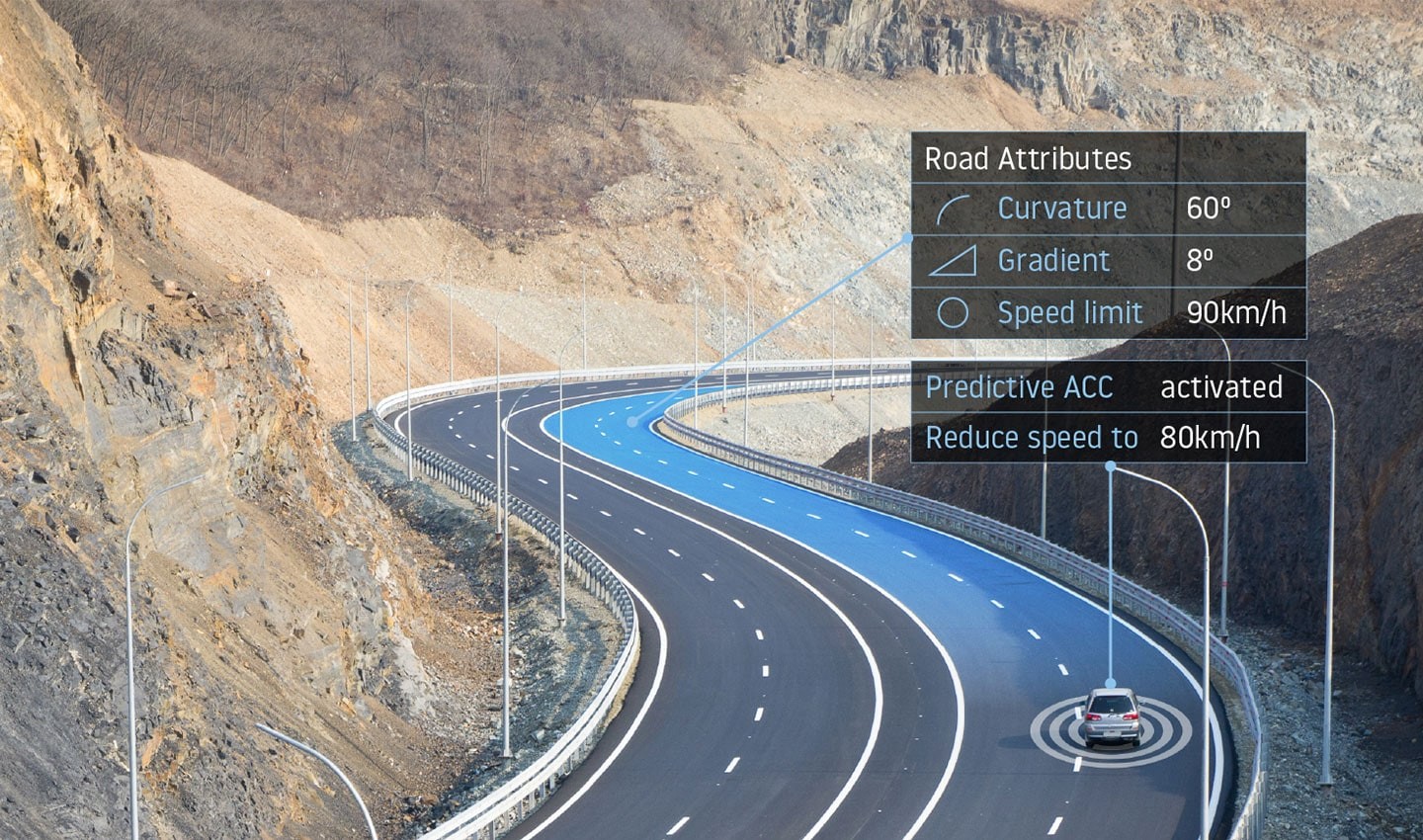
Adaptive cruise control automatically controls the acceleration and braking of a vehicle.
How adaptive cruise control works
By monitoring other vehicles and objects on the road, adaptive cruise control enables a safe and comfortable driving experience. It does so by helping the driver keep a steady vehicle speed at a given moment. The driver can set their preference regarding certain factors, such as the distance to the car in front, driving mode – for example, economical, sporty or comfortable – and others. Together with information about speed limits, road curvature, accidents data and more, these choices influence the automatically selected speed.
Cruise control has come a long way from its early days in its quest to assist drivers on the road. When first introduced, it was only found in luxury car models due to its high production cost. As less expensive sensors reached the market, adaptive cruise control is steadily becoming a standard feature in new vehicles today.
What is the difference between normal cruise control and adaptive cruise control?
The origins of normal cruise control go back to 1948, when Ralph Teetor invented the speedostat. Having greatly improved since, its focus on throttle control is still central to automation today. One example is automatically pressing the acceleration pedal, which enables drivers to take their foot off the pedal for a few moments when they are on a motorway with low traffic. The need to remain vigilant remains, so they can brake whenever required.
In the late 1990s, several carmakers started introducing a new generation of cruise control: adaptive cruise control. This technology relies on front radar to address the biggest limitation traditional cruise control had: the ability to correctly appreciate the speed of the vehicle in front.
This improvement significantly expanded the continuous operation time of the cruise control function, as automation allowed to control both the acceleration and braking of a vehicle. This allowed the driver to travel for longer distances with their feet off the pedal, even in moderate traffic situations on the motorway. Of course, the need for them to pay attention to the road ahead remained, as cars in front could still brake or suddenly cut in.
As drivers are getting more and more comfortable with using ACC while driving, the expectation for an even longer duration of continuous operation time for the system is rising. In turn, this puts pressure for it to be further improved. As new enhancements are made, the market is shifting to a new standard in ACC, called intelligent cruise control.

Intelligent speed assistance with the TomTom ADAS Map
What use cases are supported by modern adaptive cruise control?
The latest intelligent cruise control systems aim to tackle the entire journey, offloading the driver’s tasks whenever possible. Here are some of the most interesting use cases:
Stop & Go cruise control Traffic congestion is a real problem across the world. Major cities worldwide are faced with the challenge of optimizing their traffic networks. Even driving bumper to bumper at low speeds can result not only in discomfort for drivers, but also accidents. This is where Stop & Go cruise control can play a role. Operating similarly to adaptive cruise control on motorways, the difference is in slow-moving traffic, when it automatically stops or starts vehicle movement under driver supervision. The car will brake and accelerate on its own, while maintaining a safe distance from the vehicle in front.
Speed limit-aware cruise control One of the situations requiring ACC adjustment by the driver is when passing a speed limit sign. However, intelligent cruise control can automatically adjust the set speed to the newly detected speed limit, thanks to input from the traffic sign recognition system. This is done by fusing camera observation and map data to provide reliable speed restriction information.
Eco cruise control for fuel and EV capacity savings When in eco mode, cruise control adjusts the set speed so that the minimum amount of energy – whether electricity or fuel – is consumed during the journey. In a situation where a vehicle would go uphill, the system could drop the speed of the vehicle with 15-20%, in appreciation of the expected downhill speed gain shortly after. To be able to make such judgment, ACC relies on ADAS map data, specifically gradient information. Being able to rely on slope data means that the TomTom ADAS Map has been proven to provide between 5-10% fuel savings.
Cruise control in curves Especially on country roads and junctions, but also on motorways, the driver usually needs to correct the speed set by adaptive cruise control when facing bends and turns. Using curvature data from the ADAS Map, intelligent cruise control can eliminate human intervention by calculating the safe and comfortable speed for a given road segment. It does so by also considering specific vehicle dynamics. There is also ample opportunity for customization. When in sport mode, the system can cater to drivers with a sporty driving style and shows them the dynamic driving capabilities of the vehicle.
Turn-by-turn cruise control One of the most recent advancements in intelligent cruise control technology is the capability to automate acceleration and braking at highway exits, entrances, junctions and roundabouts. Even when a driver corrects the vehicle speed by braking, as soon as the pedal is released, the system resumes its activity and sets the speed according to the upcoming road feature it detects. For example, this can be a drivable profile through a roundabout. Map data is critical to this operation, as the system relies on insights based on traffic signs – stop, yield, traffic lights – and curvature at junction information.
Predictive adaptive cruise control to anticipate road hazards ahead When there is a road accident, a broken vehicle on the road or severe weather conditions such as icy roads, special caution when driving is required. Intelligent cruise control systems rely on the vehicle’s connectivity to obtain early warnings and adjust speed accordingly. The result is a safer and more comfortable journey for the driver and passengers.
Parking speed control The first and the last stage of a car journey with adaptive cruise control is always the same: controlling the speed when maneuvering in a parking or a driveway. To assist the driver in such a scenario, it is imperative to use additional sensing and very low speed. Currently, many ACC systems under development target not only self-parking, but also maneuvering through large parking lots.
Dynamic priority cruise control: an emerging technology The next step for modern adaptive cruise control systems is the ability to perceive and automatically handle changing traffic lights and other vehicles at junctions. Intelligent driving strategies that support this use case include priority negotiation and sensing a rapidly changing situation with high confidence. Of course, the driver can still observe the vehicle’s choices and intervene at any given moment.
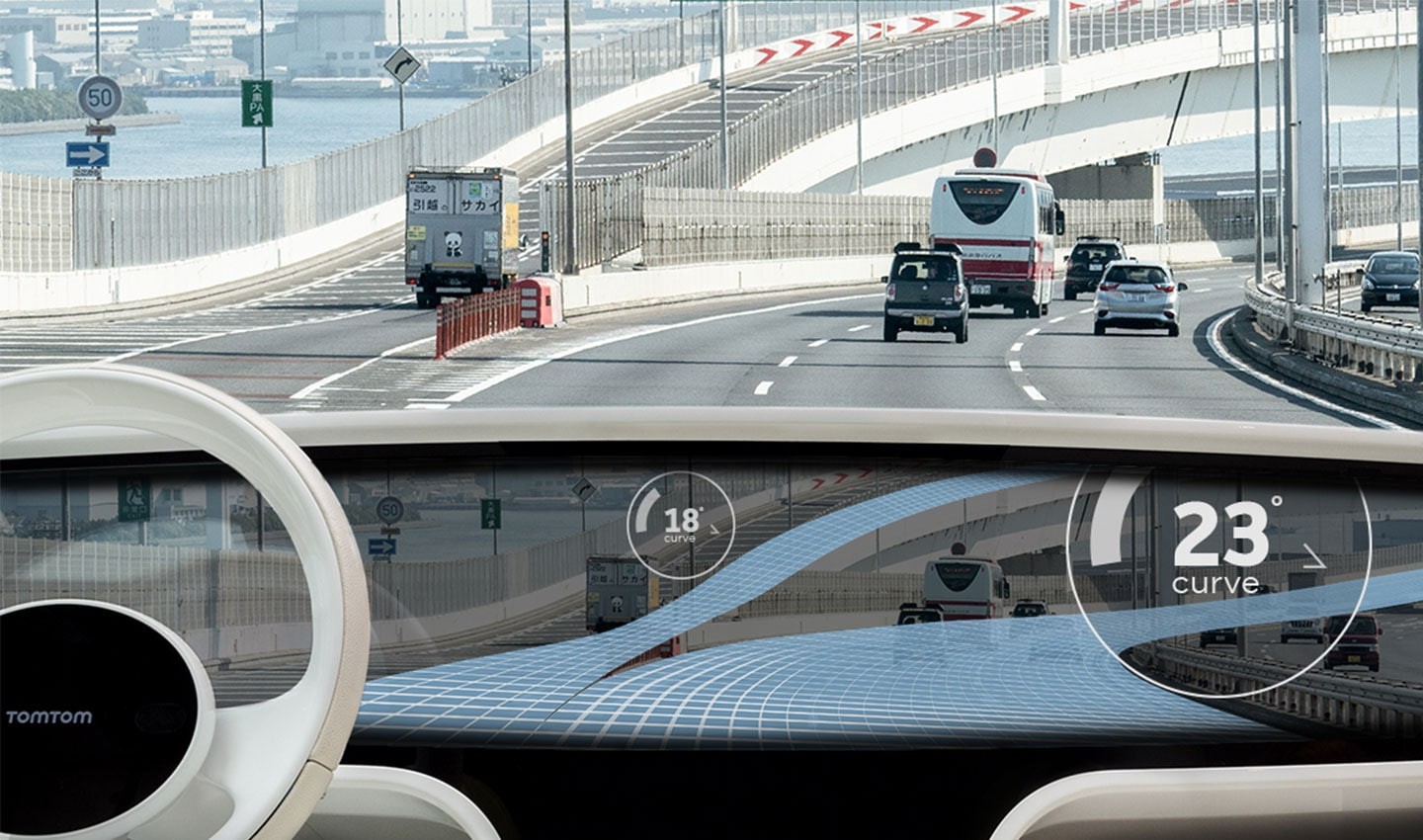
Adaptive cruise control helps drivers adjust the speed of their vehicle.
The TomTom ADAS Map: designed for intelligent cruise control use cases
Intelligent cruise control use cases rely on data beyond sensors. The TomTom ADAS Map is designed for this purpose, providing a range of attributes that power modern ADAS systems.
Since it needs to meet the highest of expectations in terms of correctness as well as being up to date, the quality of map data is of utmost importance. This way, it can confidently fulfill ADAS use cases.
“ Around the world today, over one million SAE Level 1 and Level 2 automated vehicles use the TomTom ADAS Map – both private and commercial. Having doubled in less than one year, this number is bound to rise in the future. Tsjerk-Friso Roelfzema
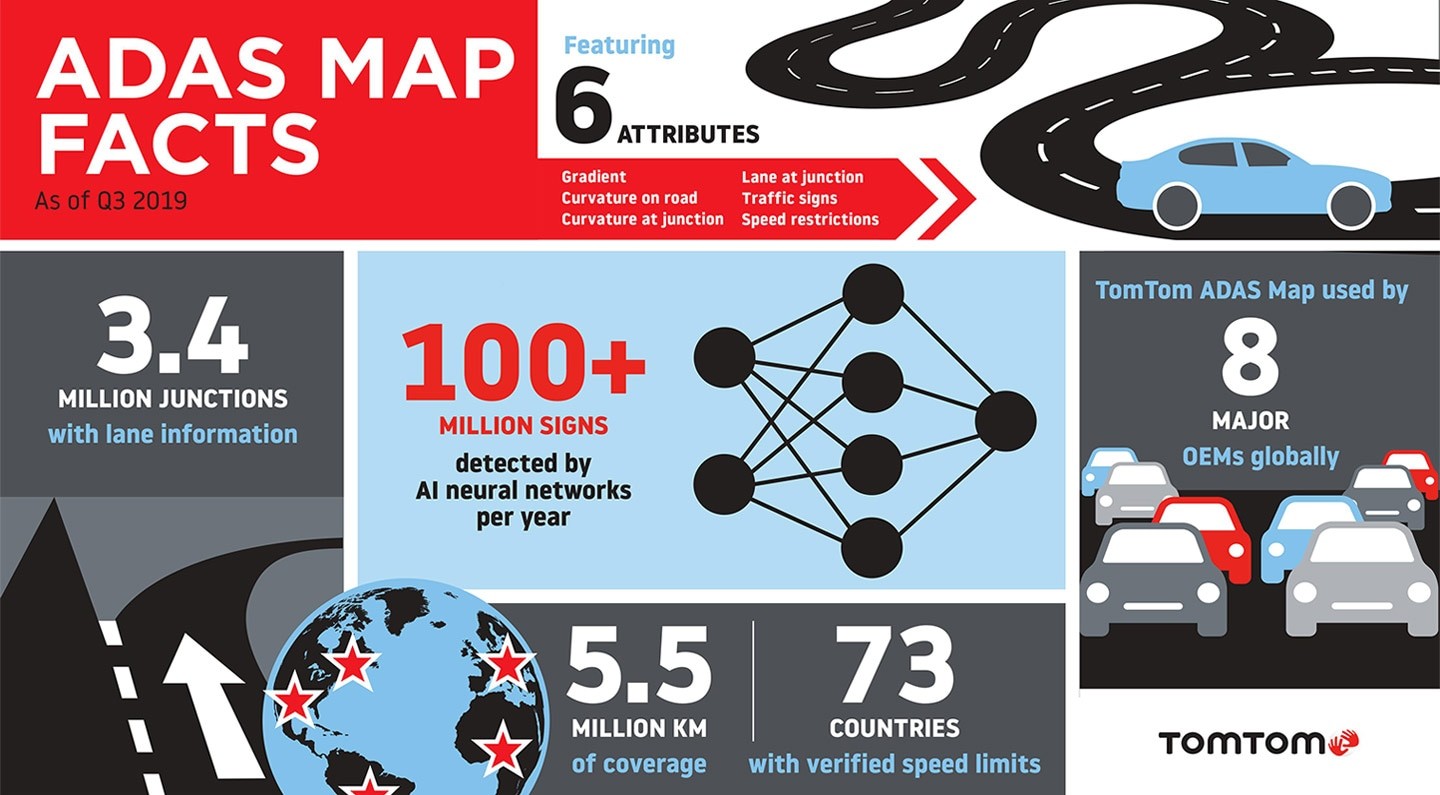
The TomTom ADAS Map covers 5.5 million kilometers in 73 countries.
The TomTom ADAS Map includes the following attributes:
Gradient Enables predictive gear-shifting to optimize energy use.
Curvature on road Helps with driving strategy choices, such as selecting a safe speed for the upcoming bend.
Curvature at junction Helps with driving strategy choices at roundabouts and junctions, without cruise control cancellation (selecting a safe speed).
Traffic sign Helps with driving strategy choices, such as fuel-efficient slowing down ahead of an upcoming stop.
Speed restriction Helps with driving strategy choices, such as selecting a safe speed.
Lane at junction Complements the vision of the system's detections. Completes curvature data for wider roads.
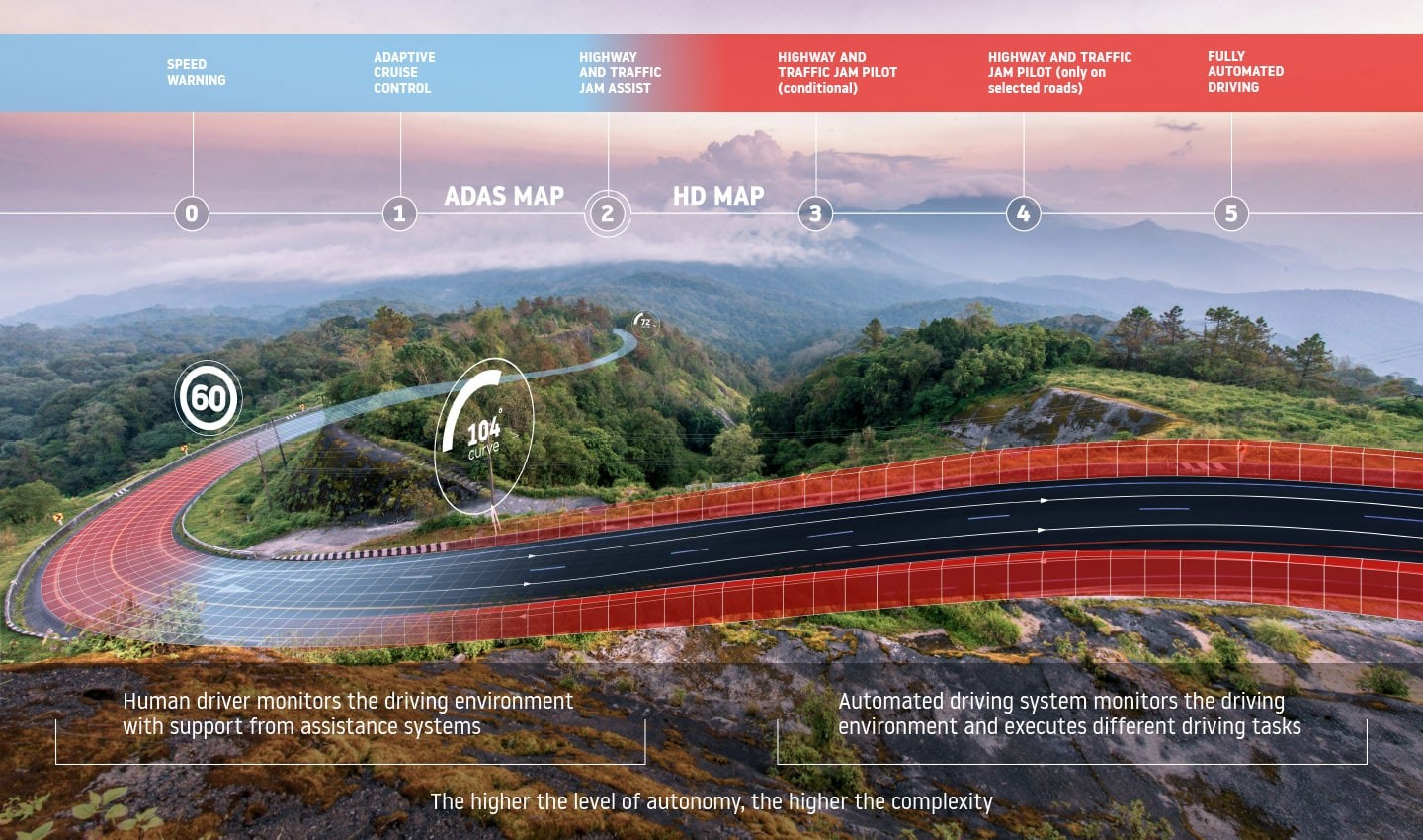
The five levels of autonomous driving
Bosch and TomTom
Bosch has developed several ADAS functions relying on TomTom ADAS Map data services for intelligent cruise control, upcoming curve alerts and jam tail warnings. All these are critical components for car manufacturers developing the latest standard in automated driving systems.
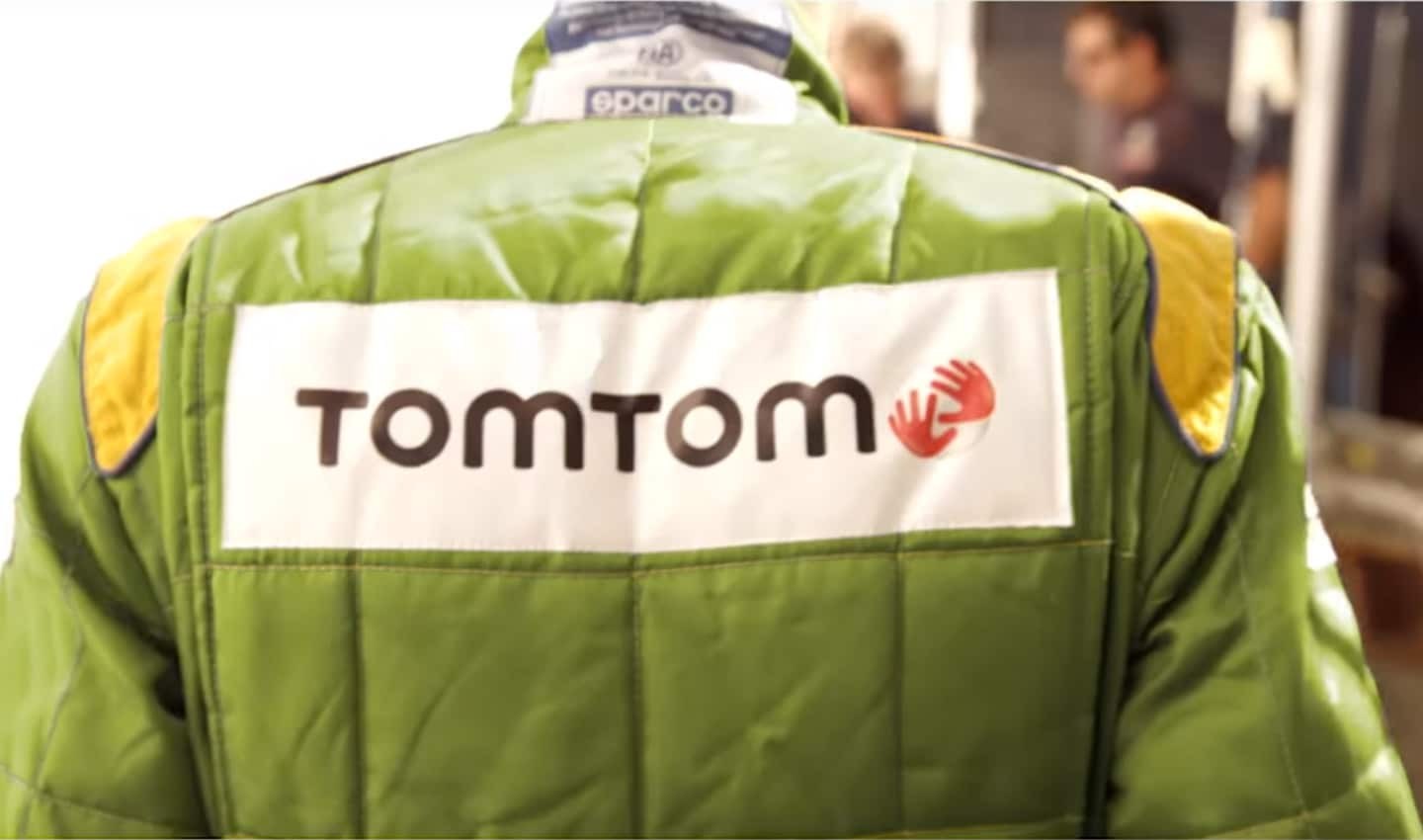
What is the future of adaptive cruise control?
The benefits of adaptive cruise control make it a worthwhile technology to continue investing in. It provides longitudinal control of a vehicle, such as acceleration and braking. Increasingly, it can be combined with steering assist technology like lane centering for automated lane changes. The longitudinal and lateral control systems working together leads to autonomous driving, the next mobility revolution, which is expected to evolve rapidly over the next decade.
TomTom creates technologies for a moving world that supports all levels of autonomous driving. To learn more about how the ADAS Map is already powering automated vehicles on the road today, download the product sheet.
Want to learn more? Download the TomTom ADAS Map product sheet.
* Required field. By submitting your contact details to TomTom, you agree that we can contact you about marketing offers, newsletters, or to invite you to webinars and events. We could further personalize the content that you receive via cookies. You can unsubscribe at any time by the link included in our emails. Review our privacy policy .
- / TomTomOfficial
- / tomtomglobal
- Navigation apps
- Personal and professional sat navs
- In-dash navigation
- Accessories
- Maps and service updates
- TomTom Orbis Maps
- Navigation Map
- TomTom Satellite Imagery
- Traffic APIs
- Routing APIs
- Map Display API
- Places APIs
- Tracking & Logistics APIs
- Automotive APIs
- Navigation SDK
- TomTom Cockpit SDK
- Navigation Engine
- Navigation User Interface
- Virtual Horizon
- How we hire
- Diversity and inclusion
- Press releases
- TomTom Traffic Index
- TomTom Customer Portal
- TomTom MOVE
- TomTom Suppliers
- Privacy policy
- Legal information
- Terms of use
- Report vulnerabilities
- Report a map change
- Tips & advice
Cruise control and adaptive cruise control: the complete guide
Cruise control is a great extra to have if you do regular motorway journeys, while adaptive cruise control arguably makes even more sense.

What is cruise control? Cruise control is an electronic system that automatically regulates a car's speed without the driver having to keep their foot on the accelerator. That's the simple answer, but today car manufacturers are adding ever-more advanced cruise control systems to their models, all designed to make driving easier and safer, while many of the newer technologies are on the first tentative steps towards autonomous vehicles .
Once upon a time, cruise control was the preserve of high-end luxury cars, but as the technology has become more affordable, car makers have rolled it out on more mainstream models. Today, you can get it on even the smallest city cars , while other models get a proprietary speed limited system that requires a bit more input from the driver.
• What is AEB?
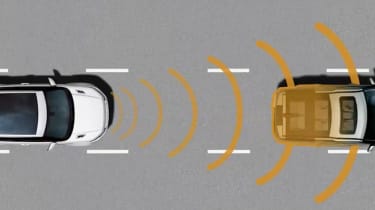
Elsewhere, the progress of technology means that car makers have been able to develop adaptive cruise control (ACC) systems that can vary a car's speed according to traffic, while the most advanced systems are on the steps towards fully autonomous driving.
Here we explain how cruise control works and break down the different kinds of system on offer, highlighting their advantages and limitations, so you can decide if it's an option that's worth ticking on your next new car purchase.
Cruise control history
Cruise control can trace its origins back to the 17th and 18th century, when engineers developed 'speed control' systems for steam engines. These mechanical systems were adapted by some early automobile makers at the start of the 20th century, although the predecessor to modern cruise control didn't appear until the 1950s.
The first car to feature cruise control was a 1958 Imperial, which was Chrysler's luxury division. Called 'Auto-pilot', the system was mechanical and was connected to the engine propshaft. It had a dial on the dashboard to preselect a speed and an electric motor that adjusted throttle position to maintain it.
US firm American Motors produced a budget version of cruise control for its automatic cars in 1965, but cruise control really took off in the US during the oil crisis of 1973. Manufacturers had developed electronic cruise control systems by this time, and these makers promoted the benefits of the system as it delivered constant throttle inputs, rather than the erratic flexing of the driver's right foot for improved fuel economy.
• What is horsepower?
Cruise control found popularity in the US first because of that nation's fondness of automatic gearboxes, long travelling distances and the relatively straight and wide highway network. In Europe, cruise control took a little longer to gain a foothold, but like the US, it first appeared on high-end luxury cars before filtering its way down to more mainstream models.
The first adaptive cruise control (ACC) system appeared in Japan in the early 1990s, although the first systems simply warned the driver of slower traffic ahead, and didn't control the car's throttle or brakes.
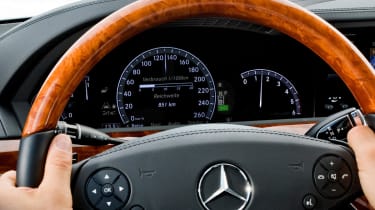
The first proper ACC system was Mercedes ' Distronic system, which appeared on the S-Class limousine in 1999. This system not only controlled the throttle, but also the brakes to maintain a set distance to the vehicle in front.
Since then, car makers have embraced ACC, and it can be found on superminis , hatchbacks and sports cars , while the rising level of traffic on our roads means it's arguably a more useful feature than standard cruise control on its own, as it can adjust speed according to traffic flow.
• What is 4x4? All-wheel-drive systems explained
How does cruise control work?
Modern cruise control systems are integrated into a car's electronics, and are often combined with additional tech, such as lane departure warning and blind spot sensors. With standard cruise control, you need to select cruise mode via a switch, then accelerate to your desired speed, and press a button – either on the steering wheel or on a lever on the steering column - to set that speed.
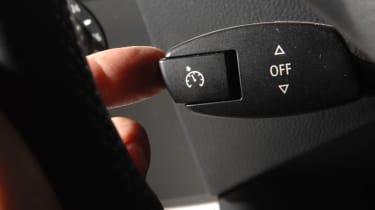
The car's electronics then maintain your selected speed, so you can take your foot of the accelerator. On some cars you can adjust your speed via a button, and the car will automatically change its speed accordingly.
On a car with adaptive cruise control (ACC), you switch on the system, then you can raise or lower your speed as desired, and the car will accelerate to that set speed. These systems use either radar or laser sensors to maintain a set distance to the car in front, and they also have the ability to increase or decrease that distance as required.
To deactivate cruise control, you simply press a button to regain control of the throttle. However, one important safety feature that all of these systems are required to have is that the system will immediately deactivate if the car's brakes are applied. On cars with a manual gearbox, pressing the clutch pedal will sometimes have the same effect, although not all cars behave in the same way. Most cars will have a memory function, so that you can resume the same speed after the brakes have been applied.
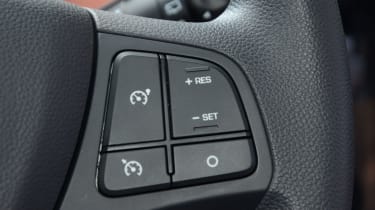
Earlier cruise control systems would have a lower speed threshold of around 20-30mph where cruise control couldn't be activated, and some manufacturers still maintain this set-up. However, some of the latest ACC systems also incorporate a traffic function, so they can operate in stop-start conditions.
Cruise control types
Essentially there are four types of cruise control on offer, ranging from the most basic speed limiter to systems that can negotiate stop-start traffic and even change lanes. We look at the benefits and disadvantages of each below.
Speed limiter
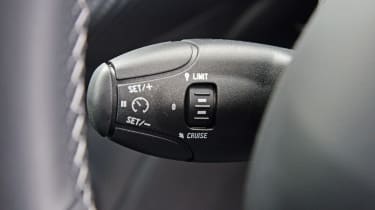
What is it? The most basic form of cruise control. There are systems that can be hard-wired into a vehicle to limit its top speed (a 70mph limit in vans, for example), or there are driver-activated systems. You can set a maximum speed for your vehicle, but you maintain control of the car's accelerator at all times. When you approach your set maximum, the car will simply stop accelerating. This will usually happen softly, so you'll barely notice.
Found on: Citroen, Ford, Nissan, Peugeot, Renault, vans, can be added aftermarket, too. Advantages: Helps you stick to speed limits, saves fuel. Disadvantages: Driver has to continue using the throttle to maintain speed.
Cruise control

What is it? Standard cruise control is a fairly common feature on new cars. You turn the system on (usually indicated by a graphic on the dashboard), then once you're up to your desired speed, you press a button to set it, and the car maintains that speed.
Found on: Most mainstream new cars, except for the most basic trims. Advantages: Takes strain out of long drives, more fuel efficient than using the accelerator manually, helps you stick to speed limits. Disadvantages: Driver has to take over when traffic slows, only worth using on clear motorways.
Adaptive cruise control
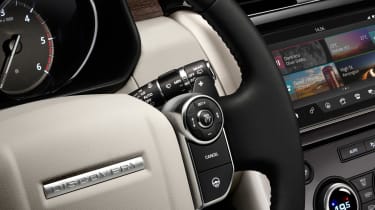
What is it? Either a radar or laser-based system that can maintain speed, but reduces speed if the gap to the car in front falls below a preset distance. This constitutes Level One automation on the automated vehicle classification chart, as they driver is required to take control at any time.
Found on: Assorted BMW, Fiat group, Ford, JLR, Lexus, Mercedes, VW Group models, and increasing in use by other makers. Advantages: Adjusts speed according to traffic, takes strain out of long drives, helps fuel efficiency. Disadvantages: Sensors can be 'blinded' in bad weather, electronics can be slow to react to sudden traffic slowing, distance to the car in front can be big enough to tempt other drivers to cut in front of you, sometime systems are jerky when changing speed.
Semi-autonomous cruise control
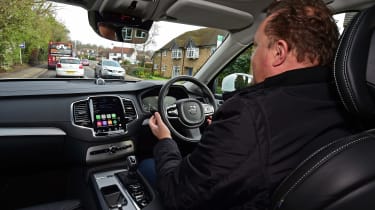
The latest hi-tech cruise control systems are one step closer to the fully autonomous self-driving car, and are classed as Level 2 automation. This means the automation can control the throttle, brakes and steering, but the driver still needs to intervene if the systems fail to detect objects. Semi-autonomous systems can vary in sophistication, and can help with steering inputs, move in stop-start traffic, or even change lanes on the motorway with the flick of an indicator, or adjust the car's speed according to GPS data and road sign recognition cameras.
Found on: Audi A3 /A8/Q7, BMW 7 Series , Mercedes S-Class , Volvo XC90 Advantages: Takes strain out of driving and traffic jams, helps fuel consumption. Disadvantages: Sensors need to be kept clear for it to work, too easy for driver to 'switch off' and lose concentration.
Do you have cruise control or adaptive cruise control on your car? Do you use it? Let us know what you think of the technology in the comments...
Dean has been part of the Auto Express team for more than 20 years, and has worked across nearly all departments, starting on magazine production, then moving to road tests and reviews. He's our resident van expert, but covers everything from scooters and motorbikes to supercars and consumer products.
Most Popular
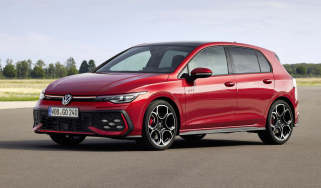
Car Deal of the Day: refreshed Volkswagen Golf GTI is a bargain at this price!

Pay-per-mile road tax: strong voices for and against possible Autumn Budget announcement
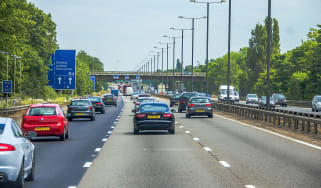
7 in 10 drivers make the same mistake when merging in-turn
How-To Geek
Why your next car needs adaptive cruise control.

Your changes have been saved
Email is sent
Email has already been sent
Please verify your email address.
You’ve reached your account maximum for followed topics.
32 Useful Microsoft Outlook Keyboard Shortcuts for Emails
I didn't shut down my windows pc for a week: here's how it went, youtube premium doesn’t seem worth it these deals might change your mind, quick links, what is adaptive cruise control, how adaptive cruise control works, what's the difference between normal and adaptive cruise control, is adaptive cruise control worth it.
There's nothing better than turning on cruise control and relaxing to some music during a road trip. And while cruise control is useful, the latest premium feature you'll want in your next vehicle is adaptive cruise control (ACC), and here's why.
Whether you buy a fancy electric vehicle or the latest RAM 1500 Rebel, cars these days come with all sorts of exciting technology. Many of the luxury features from several years ago are becoming mainstream and are available on more models. Below we'll tell you what you need to know about adaptive cruise control, how it works, and if it's worth the upgrade.
Adaptive cruise control (ACC) is a popular feature on many vehicles, and it goes by several different names. Brands may advertise it as ACC, dynamic cruise control, intelligent cruise control, radar cruise, or even automatic cruise control.
Related: 7 Awesome Ford F-150 Lightning Electric Truck Features
Those names should tell you everything you need to know. Like regular cruise control, adaptive cruise control (ACC) helps a vehicle maintain a safe speed set by the driver. However, it's not just a setting that keeps your car at 78-mph going down the highway.
Instead, it's an entire system designed to help vehicles maintain a specific speed and a safe distance from others on the road. This system still adjusts the speed automatically, so drivers don't have to, but it also can apply the brakes and stay within a set distance from other vehicles.
The type of ACC your vehicle has will determine some of its features or how it works. The system uses onboard computers and sensors, often including radar or lasers, and can automatically monitor other vehicles and objects on the road.
Once you lock your preferred speed into the system, the computers take over the throttle and brake controls. Many ACC systems will even let you adjust the distance to the car in front of you. Then, the vehicle will automatically slow down and match the vehicle ahead's speed, letting you "tailgate" safely, as shown in our image above. If that car moves over, your modern car will automatically accelerate again and reach your desired speed.
You don't have to hit the brakes, tap the cruise control stem to lower your speed, or do anything when a slower car is in front of you. The system handles everything.
Many modern vehicles offer ACC with stop-and-go or brake-hold features, too, where it can combine all the settings into one. For example, some Ford models can handle stop-and-go traffic, keep a set distance from the vehicle ahead, and follow a car to a stop. Then, reach its designated speed later when possible or after a light turns green. If you've never driven a car with ACC, It's a game-changer.
Related: How to Use Less Gas and Increase Your Car's Mileage
Some cars even take things further with adaptive cruise control and will let owners set a driving mode. For example, you could select ACC with economy mode and it'll slowly accelerate for better fuel economy. Or, some allow for "sport" mode, where the vehicle will accelerate back to the preferred speed as quickly as possible.
Additionally, more advanced ACC systems integrate into the maps and navigation system, cameras, and other autonomous driving features to slow down around sharp turns, reduce speeds automatically based on posted speed limits, etc.
You can even pair it with lane assist features for seriously comfortable driving. But remember, you'll always want to have your eyes on the road and your hands on the wheel.
Modern cruise control was invented in 1948 by the American engineer Ralph Teetor. Fun fact, the first car to offer cruise control was the 1958 Chrysler Imperial, and the automaker marketed the feature as "auto-pilot."
Basic cruise control automatically presses the acceleration pedal or holds it at a certain spot, enabling drivers to take their foot off the pedal in specific situations. Over the years, auto manufacturers improved the feature set by leaps and bounds.
For example, my old 2011 Toyota Tacoma has cruise control, but it's nothing fancy. I can turn it on, set a speed, then manually click the control stem up/down to increase or decrease my speed if needed---but it barely works. Once I tap the brake, it's all over, and everything shuts off. However, there is a resume button I can easily tap to let the system instantly go back to my previously set speed. That's about the extent of its control.
And while that's moderately helpful, driving with ACC is a vastly better experience. Adaptive cruise control isn't anything new, either. Unfortunately, the feature was reserved for more expensive luxury vehicles back in 2011.
These days adaptive cruise control is readily available in cars of all different price points. Whether that's an expensive new BMW, a big offroad RAM Rebel truck, a family Honda CR-V, or even more affordable cars from Hyundai and KIA.
Related: The Electric Truck Problem No One Is Talking About
Up until just a few years ago, unless you were buying a luxury car, ACC was typically reserved for higher trim levels that cost extra. And to a degree, that's still the case. Many vehicles come in a base package with countless features missing, like navigation, extra safety controls, and ACC. But those are easily added with a premium package or a higher trim of the specific vehicle.
So, is adaptive cruise control worth it? Absolutely. As we said earlier, it's a game-changer, especially on longer road trips. Old-school cruise control was barely worth the effort it took to turn on, but modern ACC is 100-percent worth the increased price.
Thankfully, with the rise in technology almost any new car is essentially a giant computer, and most new automobiles come with advanced or adaptive cruise control. For example, Toyota now considers adaptive cruise control "standard equipment" on all vehicles.
If you're looking to buy a new or lightly used car anytime soon, make sure your next ride has adaptive cruise control. You can thank me later.
- googlenewsfeatures
- Car technology
Cruise control and adaptive cruise control explained
Cruise control is a handy feature for long journeys – we explain how to use it.
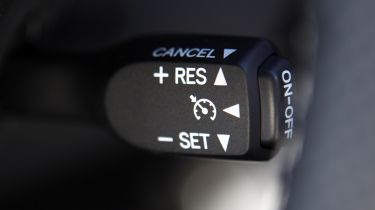
Cruise control has become a common feature in modern cars, allowing drivers to maintain a steady speed without using the accelerator pedal. Ideal for long motorway drives, traditional cruise control allows you to set a specific speed, giving your right foot a much-needed break. While this tech has been around since the 1960s, the system has evolved in recent decades. The latest adaptive cruise control (ACC) systems use sensors to monitor the traffic ahead, automatically adjusting your car’s speed to maintain a safe following distance.
Different carmakers have their own versions of these systems – Audi’s ‘Adaptive Cruise’, BMW’s ‘Active Cruise Control’, and Volvo’s ‘Pilot Assist’ are just a few examples – and some are more intelligent than others, even changing lanes and steering autonomously. Some cars are also equipped with ‘Traffic Jam Assist’, which can handle stop-and-start traffic, easing the stress of daily commutes.

From straightforward speed control to sophisticated, traffic-responsive systems, cruise control technology can help to take some of the stress out of long journeys. Read on to explore how these features work and how to use them.
What is cruise control?
Cruise control is a system that maintains the speed of a car automatically. Using controls found on or behind the steering wheel, the driver can set a desired speed that the car will continue to follow without any use of the accelerator pedal. It’s found in cars with an automatic or manual gearbox, although its functions are usually more limited in the latter. Most electric cars also come with cruise control.
It’s designed to be used on long A-road or motorway journeys, when prolonged use of the accelerator pedal could cause cramp or soreness in the driver’s right foot. Once a speed has been set, the driver can relax their foot and focus on controlling the car’s steering. The first cruise control systems held the throttle open mechanically, but modern systems are computer-controlled. Many cruise control systems will only activate above a certain minimum speed, usually around 25 to 30mph.
What is adaptive cruise control?
Adaptive cruise control (often abbreviated to ACC) is a more advanced cruise control system that uses lasers, cameras or radar mounted in the front bumper to track the speed and position of the vehicle in front. Cars fitted with the system can automatically match the speed of the vehicle in front and maintain a safe distance. Many systems allow the driver to set their preferred distance to the vehicle in front.
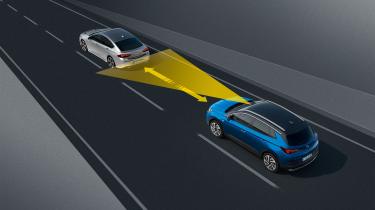
If the vehicle ahead slows down, the driver’s car will also slow down without the need to use the brake pedal. If the vehicle ahead speeds up, the driver’s car will only speed up until it reaches the limit set by the driver. However, only systems paired with an autonomous emergency braking (AEB) system will automatically perform an emergency stop if the car ahead comes to a sudden halt. In 2024 AEB was made a legal requirement for all new cars sold in the UK and the EU.
Adaptive cruise control is sometimes referred to as ‘dynamic’ cruise control, while other automakers use their own names; Mercedes calls it ‘Distronic Plus’ and Porsche, ‘Porsche Active Safe’.
Some vehicles even have ‘Traffic Jam Assist’, an extension of adaptive cruise control that can automatically slow the car to a halt as well as accelerate and brake at low speeds in congestion, reducing driver fatigue. It’s worth noting that after coming to a halt for more than a few seconds, safety requirements mean driver intervention is usually required; squeezing the accelerator should allow Traffic Jam Assist to resume.
How do I use cruise control?
Check your car’s handbook for the location of the cruise control buttons as they differ from vehicle to vehicle. They are often found in an easy-to-access location, such as on the steering wheel or column stalk, to make them quick and safe to use.
The system can be overridden at any time by pressing on the brake pedal, so you should keep your foot close to the brake in case of emergencies. There may be differences in controls between different manufacturers, so always read your car’s handbook first. Some typical cruise control buttons include:
- On/off: This activates the system, but probably won’t hold you at your desired speed. Turning it on will almost always be accompanied by a dashboard light.
- Set: Once the system is switched on, pressing the set button should tell the car to hold the current speed. In most cars this will turn the dashboard indicator green.
- Cancel: This pauses the cruise control, so you have complete control again, without turning cruise control fully off. The cruise control should still remember the speed you chose to cruise at.
- Res or resume: Pressing this will see the car accelerate back up to the speed you chose before hitting the cancel button or pressing the brake pedal. You'll still need to change gears in a manual car if necessary. An automatic gearbox will change gears for you.
- Up and down arrows or ‘+’ and ‘-’: With cruise control activated, use these to increase or decrease the car’s speed. Single presses often increase or decrease the speed in small increments, while holding the same button or stalk changes it in increments of 5mph or even 10mph. Of course, this varies from one model to another.
Cruise control is best used on long stretches of motorway and should be used to maintain a safe speed while the driver pays full attention to their surroundings. Drivers should not treat cruise control like an autonomous driving system, and the driver needs to pay as much attention to the road when using cruise control as they do with regular driving.
What is a speed limiter?
Some cars are fitted with a speed limiter, either alongside cruise control or on its own. As with cruise control, you set the maximum speed you’d like to travel at, but unlike cruise control, you're still required to press down the accelerator. This is ideal for busy speed-limit zones, where you may want to maintain complete control of your speed without exceeding the limit. Squeeze the accelerator, and your car will simply reach your chosen speed and stop accelerating. However, pressing the throttle pedal all the way down will override the system –it’s a fail safe designed to let you accelerate out of trouble if needed.
What about Intelligent Speed Assistance?
Like Autonomous Emergency Braking (AEB), Intelligent Speed Assistance (ISA) is another mandatory safety feature fitted to every new car sold in the UK and the EU from 2024. Unlike a traditional speed limiter above, the ISA system uses your car’s GPS and traffic sign recognition cameras to determine the road’s speed limit. The ISA system then limits your car to this speed, stopping you from breaking the speed limit.
The system can be overridden in certain situations when the driver pushes hard on the accelerator pedal, and it can be turned off entirely. However, the system is automatically reactivated every time you start the car. From July 7th 2024, it is a legal requirement for every new car sold in the UK to come with the technology, including unsold new cars sitting in dealerships that will need to have the system retrofitted.
What is the benefit of cruise control?
When should i use cruise control, is cruise control safe, does cruise control save fuel, car technology made simple….
- What are brake pads and discs?
- What is autonomous emergency braking?
- What is ESP on a car?
- What is traffic jam assist?
- What are blind spot monitoring systems?
- What is cross traffic alert?
- Euro NCAP: how safe is my car?

Charlie writes and edits news, review and advice articles for Carbuyer , as well as publishing content to its social media platforms. He has also been a regular contributor to its sister titles Auto Express , DrivingElectric and evo . As well as being consumed by everything automotive, Charlie is a speaker of five languages and once lived in Chile, Siberia and the Czech Republic, returning to the UK to write about his life-long passion: cars.
Recommended
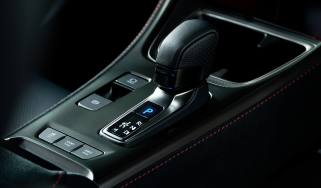
What is a CVT gearbox? Reliability, pros and cons
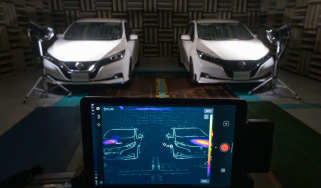
Turn off the air-con! New Nissan ‘cool’ car paint cuts cabin temp by 5 degrees
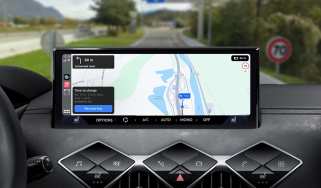
Stellantis e-Routes app brings advanced EV route-planning to Apple CarPlay and Android Auto
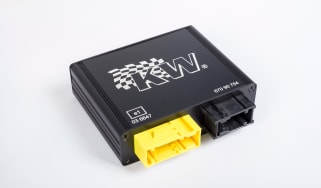
Car ECU explained: What it does, faults and repair costs
Most popular.

Best new car deals 2024: this week’s best PCP finance offers
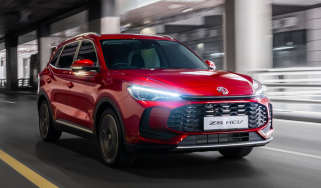
All-new MG ZS Hybrid+ is the cheapest hybrid SUV you can buy
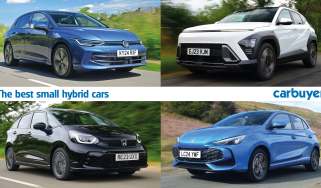
Top 10 best small hybrid cars 2024
Tips & advice

Car dashboard warning lights: the complete guide

Electric car charging stations: public networks, charger types, apps and maps

PCP vs HP – which type of car finance is right for you?

Average speed cameras: how do they work?

Top 10 best car interiors

Top 10 best electric cars 2024

Top 10 best cheap-to-run cars 2024

The UK's top 10 fastest hot hatchbacks 2024

- Schedule Calibration Appointment
- Location Announcements
- ADAS Technician Training
- Press Releases
- Own A Calibration Center
- ADAS Glossary
Adaptive Cruise Control: What is ACC in ADAS?
- June 3, 2021
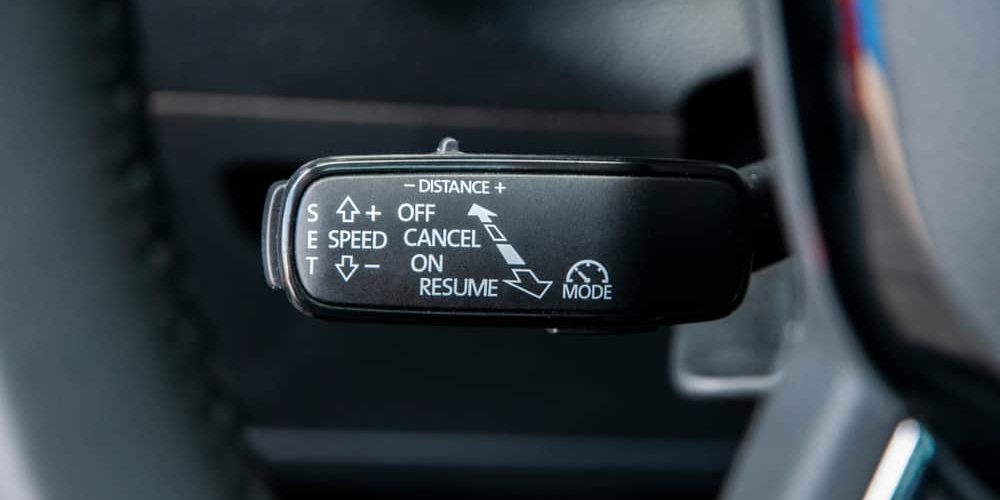
Table of Contents
What is ACC in ADAS?
When it comes to cars, ACC stands for Adaptive Cruise Control. In a Consumer Reports survey , 85 percent of drivers with Adaptive Cruise Control (ACC) on their vehicles said they were very satisfied with it. What’s more, 19 percent said their ACC system helped to avoid a crash.
Standard cruise control has been around since the 1950s . Adaptive cruise control has been in development since the 1990s . Mercedes was the first automaker to bring ACC to the U.S. market in 1999 . Twenty years later, automakers are still working to improve their cruise control offerings. In the meantime, ACC technology has become one of the building blocks of autonomous driving.
In this article, we will explain adaptive cruise control and how it works, provide examples of ACC features in ADAS packages, and explain the importance of adaptive cruise control calibration.
What is Adaptive Cruise Control?
Adaptive cruise control or Active Cruise Control (ACC) is an advanced driver assistance system (ADAS) that automatically adjusts a vehicle’s speed when there are slow-moving vehicles ahead, with the aim of maintaining a safe following distance. When the road ahead is clear, ACC automatically accelerates to your pre-set speed. Adaptive cruise control is ideal for highway speeds.
ACC is a major component and precursor of fully autonomous vehicles. According to SAE , Driving Automation Level 1 driver support features provide steering OR brake/acceleration to the driver while the jump to Level 2 requires features that provide both steering AND brake/acceleration to the driver. On its own, ACC is a Level 1, but when combined with another driver assist feature that steers, your vehicle reaches Level 2 on the Driving Automation scale – a step closer to fully autonomous driving .
As a foundation of autonomous driving, ACC has the capability of reducing driver stress and radically improving driver safety. A study from the Highway Loss Data Institute studied insurance claims data from 2013-2017 BMW vehicles to see how ADAS affected collision, damage, and injury rates. The BMW Driving Assistance package added ACC to the following ADAS: Forward Collision Warning , Lane Departure Warning , Front Automatic Emergency Braking . With the addition of ACC, this package reduced the rates of property damage by 27 percent and bodily injury claim rates by 37 percent.
How does Adaptive Cruise Control work?
Just as with traditional cruise control, the adaptive cruise control system requires drivers to choose their preferred speed. Next, ACC requires drivers to set their preferred following distance from the vehicle’s pre-set options. Many have close, medium, and far selections to toggle between.
Sensors Used in Adaptive Cruise Control
Vehicles with adaptive cruise control use ACC sensor data to tell your car’s speed, distance from other vehicles, and the speed of vehicles ahead of you. There are many types of adaptive cruise control technology. The following types of sensors have all been used for ACC:
- Laser (Lidar)
Most (but not all) current forms of this ADAS use radar as their main source of information. A radar sensor mounted in the front of the vehicle is used to analyze the road ahead. It does this by emitting radio waves and measuring how long they take to return to the ACC sensor. A few internal calculations and your vehicle can tell the car’s distance and speed. Data from the radar distance sensors and the vehicle speed sensors are used to adjust your speed and keep your car a set distance from the one ahead of you.
ACC System Versions and Commonly Bundled ADAS
Most automakers have their own version of adaptive cruise control. Not everyone uses the same names for their ACC system. Here are a few industry terms that are all different names for ACC:
- Dynamic cruise control
- Intelligent cruise control
- Radar cruise control
- Radar adaptive cruise control
- Dynamic laser cruise control
- Autonomous cruise control
- Smart cruise control
- Dynamic radar cruise control

ACC with Stop & Go, Traffic Jam
Beyond the similar naming, there are several different features that adaptive cruise control is often bundled with to provide sensor fusion. One example of this is a feature called ACC with Stop and Go or ACC with Traffic Jam Assist. This adds the ability to come to a complete stop via automatic braking and then re-accelerate to the car’s set speed as traffic moves. All the while, data from sensors is used to keep a set, safe distance from cars ahead when you encounter heavy traffic.
Because it’s not an autonomous car, those with stop and go capabilities will only “go” again within three seconds if traffic flow allows. If it’s longer than three seconds, driver action is needed to re-engage the system.
ACC + Forward Collision Warning & Automatic Braking
Forward Collision Warning and Automatic Emergency Braking (AEB) advanced driver assistance systems are often combined with ACC to provide audible alerts, instrument panel alerts, and tactile warnings of a forward collision risk, then automatic braking to prevent or mitigate damage from a collision.
ACC + Lane Centering
Adaptive Cruise Control works well with others. As previously mentioned, when adaptive cruise control is combined with an ADAS with steering capabilities like lane centering and proactive lane keeping assist systems, your car is considered a Level 2 on the SAE autonomous driving scale — meaning that the vehicle can accelerate, decelerate, and steer on its own — under very specific conditions, including initiation speed and weather. While it’s a step up in terms of driving automation, for safety, a human driver is still required to supervise constantly, including steering, braking, or accelerating.
ACC + GPS or Traffic Sign Recognition
Some ACC systems offer advanced traffic sign recognition , while others utilize GPS speed limit data. These optional ACC features help to combat the use of ACC technology to speed.
4 Examples of Adaptive Cruise Control
There are many different flavors of ACC. Names, tech, and bundled features make the automotive landscape — dotted with endless features, diverse names, and function variations — a bit tricky to navigate. To help you recognize ACC features, here are four automaker examples.
Ford Adaptive Cruise Control
Ford is one example of an automaker with adaptive cruise control. Here’s how Ford’s describes its system and capabilities:
“Available on select Ford vehicles is a series of Adaptive Cruise Control (ACC) features employing advanced radar and camera technology. ACC lets you set a cruising speed and distance from the vehicle ahead of you. When it slows down, you automatically do too; when traffic picks back up, you resume your preset speed and distance. Then comes ACC with Stop-and-Go, which enables you to come to a complete stop when the vehicle ahead stops. Now add Lane Centering, which scans the lane markings to help you stay in your lane if the system detects you’re drifting out of it. And that’s not all. Now there’s Intelligent Adaptive Cruise Control, which includes all of these features plus new Speed Sign Recognition that can automatically adjust the set speed of your vehicle to the posted speed limit.”
Honda Adaptive Cruise Control (ACC) with Low-Speed Follow
In the Honda Sensing ADAS package, the automaker offers ACC on many 2021 models with what it calls Low Speed Follow. Here’s how Honda describes it :
“Cruising on the open highway has never been easier! Honda’s Adaptive Cruise Control (ACC) with Low-Speed Follow lets you set your cruise speed and interval behind a vehicle detected ahead, and then maintains that interval by braking your vehicle or applying the throttle. And the Low-Speed Follow function can bring your vehicle to a complete stop when a vehicle detected ahead slows to a stop, and it lets you resume operation by pressing a button or the accelerator.”
Hyundai Smart Cruise control (SCC) with Stop & Go
Hyundai offers adaptive cruise control, including on the Santa Fe. Here’s how the automaker describes it :
“While traveling at a speed set by you, it uses radar to maintain a safe distance from the car ahead. When the system slows the vehicle to a stop, it will reactivate if the vehicle in front moves within 3 seconds.”
Hyundai also offers Highway Driving Assist that works together with Smart Cruise Control. Here’s how Hyundai describes this feature :
“Your “co-pilot” for highway driving, when actively engaged with Smart Cruise Control or Lane Following Assist, this smart convenience automatically helps keep you centered in your lane and traveling at a safe distance behind the car ahead. Not only that, it also can keep you driving at the right speeds, automatically setting your pace based on GPS and highway data.”
Subaru EyeSight Adaptive Cruise Control
As part of Subaru’s Eyesight Driver Assist Technology Package, ACC is standard on many of the brand’s 2021 models and optional on the rest. It uses dual forward-facing color cameras mounted near the rearview mirror. Here’s how Subaru describes its ACC system in a promotional video :
“With adaptive cruise control, eyesight can help you stay with the flow of traffic. When you set cruise control, you can select from up to four present following distances. EyeSight watches ahead and if it detects traffic is slowing, adaptive cruise control adjusts your speed accordingly to keep your selected distance. Once traffic starts moving faster, it can automatically accelerate back up to your set speed. It can even work in stop-and-go traffic.
For some, it’s less worry about adjusting cruise control. For others, it’s like having an extra set of eyes on the road.”
Adaptive Cruise Control Limitations
Drivers should know that they are responsible for what happens when they are behind the wheel. Every company makes sure to include an asterisk and notice that drivers are still needing to be actively engaged in driving. Some drivers are using ACC to speed . A study of 40 drivers by the Insurance Institute for Highway Safety (IIHS) found that they were more likely to speed when equipped with ACC.
ACC works well in clear day and night driving, and in light weather. However, if there is fog, heavy rain, or snow, it won’t work. Additionally, if dirt, snow, or ice are on the sensors, they won’t work. ACC also has trouble on winding roads.
With or without ACC, it’s important to always leave more space during poor driving conditions, including inclement weather.
Adaptive Cruise Control Calibration
ACC is one of the most common ADAS features in vehicles today. Like other ADAS systems, ACC needs to have sensors recalibrated after a collision and many vehicle services like windshield replacement . ADAS calibration keeps ACC systems working properly.
What is adaptive cruise control calibration?
Adaptive Cruise Control calibration takes place when the camera, lidar, and radar sensors that inform your vehicle’s actions are re-aligned to improve or re-establish sensor accuracy.
Getting a car calibrated takes drivers knowing about it and recognizing the warning signs.
ACC Calibration Warnings for Drivers
For drivers, the biggest sign that you need a car calibration is a recent collision. Other circumstances that necessitate Adaptive Cruise Control calibration include any time you repair or replace something nearby the location of a sensor. Another sign would be an overly sensitive ACC system, even when you have changed the settings (where possible). Here are some related warning messages that may signal it’s time to get an ADAS calibration:
- Adaptive cruise control sensor blocked
- Adaptive cruise control failure
- Adaptive cruise control temporarily unavailable
ADAS Calibration for Auto Shops
When a car comes into the shop, techs need to know when to order or perform ADAS calibrations . They also need to understand their importance. If calibrated incorrectly, ACC systems may have following distance settings that drivers aren’t used to. They can also make the systems overly sensitive, or not sensitive enough.
Every new model year brings more and more ADAS-equipped vehicles to the streets. Cars need to be calibrated after collisions, and any repairs that may affect sensor alignment. If you want to capitalize on this impending influx of needed calibrations, Car ADAS Solutions can help. We are at the forefront of the ADAS calibration services industry. We provide turnkey ADAS calibration solutions with framework, specialty software, training, and support, built-in. Contact Car ADAS Solutions today !
Additional ACC Resources:
- Cars with Adaptive Cruise Control – Car and Driver
- 10 Best Cars with Adaptive Cruise Control – TrueCar
- Adaptive Cruise Control – MyCarDoesWhat.org
Adaptive Cruise Control FAQs
What is Adaptive Cruise Control (ACC) and how does it differ from regular cruise control?
Adaptive Cruise Control is an advanced driver assistance feature that automatically adjusts your vehicle’s speed to maintain a safe distance from the vehicle in front. Unlike traditional cruise control that maintains a constant speed, ACC can speed up or slow down based on the flow of traffic.
ACC uses a combination of radar, cameras, and various other sensors to monitor the distance to the vehicle ahead and its relative speed. This data is processed by the car’s computer systems to adjust the throttle and apply brakes if necessary, ensuring a safe following distance.
Can Adaptive Cruise Control bring my car to a complete stop?
Yes, many modern Adaptive Cruise Control systems come with stop-and-go technology that can bring your vehicle to a complete stop and then resume driving when traffic starts moving again.
Is Adaptive Cruise Control safe to use in all driving conditions?
While ACC is designed to increase safety and convenience, it is most effective in steady traffic conditions on highways or well-marked roads. It is not recommended for use in city driving, in adverse weather conditions, or on roads with poor lane markings as these factors can reduce the system’s effectiveness.
Will Adaptive Cruise Control work with any vehicle ahead of me?
Adaptive Cruise Control is generally designed to recognize and respond to most passenger vehicles and trucks. However, it may not detect objects small vehicles like motorcycles and bikes, or pedestrians. This is why it’s best to avoid using in dense cities.
Share this post
Related Articles

What is ADAS? Advanced Driver Assistance Systems (ADAS) Guide

Understanding ADAS: Automatic Emergency Braking (AEB)

Rear AEB: The ADAS That’s Putting the Brakes on Backing Crashes

New Automotive Night Vision ADAS Technology Illuminates Driving at Night

Basic Guide: ADAS Calibration Equipment

Implementing ADAS Calibration: 6 ADAS Challenges Most Shops Face (and What to Do About Them)
Subscribe To Blog Updates
Get notified when a new blog post is released!
Own Your Own ADAS Calibration Center
Enjoy high profits in an industry that is growing exponentially!
- Privacy Policy
Salt Lake City Calibration
- SLC Calibration Center
- ADAS Calibration Services
- Schedule Calibration
Calibration Centers
- Calibration Center Locations
- (801) 810-1150
- (855) 500-1533 Toll Free
- [email protected]
© 2020 Car ADAS | All rights reserved | Utah SEO & Utah Website Design by Ranksey
What Is Cruise Control?
How does cruise control work.
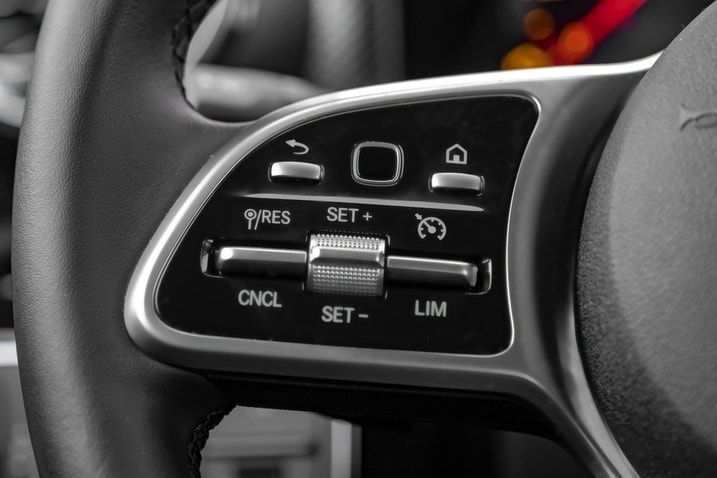
Photo: Marin Tomas | Moment via Getty Images
Cruise control is a vehicle feature that allows drivers to maintain a given speed on the highway without having to keep their foot on the accelerator pedal. This feature helps reduce fatigue, especially on long highway trips, by lessening muscle strain in your right leg. The vehicle will also be more fuel-efficient when using cruise control in specific scenarios. You're also less likely to get pulled over when using cruise control since you can set it exactly at the speed limit and not worry about accidentally going faster.
How to use cruise control
There is typically a button on the steering wheel to engage cruise control, set your speed, adjust your speed, or turn it off. Cruise control buttons from most automakers are usually depicted by a speedometer logo or labeled “cruise.” Some vehicles, like the previous-generation Toyota 4Runner and Tacoma, have cruise control stalks on their steering columns.

Photo: Anzeletti / E+ via Getty Images
Once the desired speed is set, the car’s onboard computer maintains the selected speed. In most vehicles, you can’t use cruise control at low speeds under 25 mph. However, some off-road trucks and SUVs like the Ford Bronco and Toyota Land Cruiser have low-speed cruise control for trail use. You can adjust the speed up or down using buttons on the steering wheel or by simply using the accelerator pedal. If you hit the brakes, cruise control will shut off.
What is adaptive cruise control?
Adaptive cruise control started showing up in cars at the turn of the millennium and maintains a selected speed but also uses sensors to detect the vehicle in front of you. There are usually various distance settings to choose from, typically several car lengths, and the system adjusts your speed to ensure you stay at that distance. So, with adaptive cruise, you don’t have to hit the brakes or cancel the system if there’s a slower car in front of you. Cruise control and adaptive cruise control systems aren’t self-driving features; you can learn more about the various levels of autonomy here .
Does cruise control save gas?
Yes, as long as you’re driving on a flat surface and maintaining a consistent speed for an extended period. You’ll want to adjust your speed with your right foot if you’re ascending or descending a steep grade or driving in inclement weather because cruise control will keep its speed regardless of the surface the vehicle is driving on.
See Edmunds pricing data
Has Your Car's Value Changed?
Used car values are constantly changing. Edmunds lets you track your vehicle's value over time so you can decide when to sell or trade in.
.jpg)
Connor Hoffman has worked in the automotive industry since 2018 in both editorial and public relations. He has tested and written about hundreds of cars and helped lead the media launches of the 2024 Toyota Tacoma and Land Cruiser. Connor is a correspondent at Edmunds and started his career at Car and Driver after a summer internship. He has also contributed to U.S. News & World Report and Capital One Autos. He loves four wheeling and camping in his fourth-gen 4Runner and hopes to one day restore a 60- or 80-Series Land Cruiser.
.jpg)
Brett T. Evans has been an auto writer for more than a decade with 2,000 articles under his belt, covering topics as varied as tuned diesel trucks, modern supercars and experimental electric vehicles. Brett contributes to Edmunds and has also written for Petrolicious, MotorTrend, Out Motorsports and Motor1, among others. When he's away from his desk, Brett enjoys off-roading in his 1996 Lexus LX 450 or cutting up a twisty road in his 2006 BMW Z4 3.0si — sometimes with a border collie named Lilly in tow.

Other research topics
What shoppers are searching for, popular new cars.
- New GMC Savana Cargo
- New Toyota Grand Highlander Hybrid
- New Toyota Highlander Hybrid
- New Chevrolet Express Cargo
- New Lexus RX 350h
- New Toyota Camry Hybrid
- New Subaru Forester
- New Toyota Corolla Cross Hybrid
- New Kia Sportage Hybrid
- New Lexus UX
- New Chevrolet Express
- New Volvo XC60
- New Toyota RAV4 Prime
- New Honda CR-V
- New Chevrolet Bolt EUV
- New Kia Sportage Plug-In Hybrid
- New Subaru Outback
- New Honda Pilot
- New Honda Passport
- New Volvo EX90
- New Lexus NX
- New Lexus TX
- New Volvo EX30
- New Kia Sorento Hybrid
- New Hyundai Kona Electric
- New Buick Envista
- New Hyundai Tucson
- New Subaru Crosstrek
- New Volkswagen Atlas Cross Sport
- New Mazda CX-30
- New Audi SQ5 Sportback
- New Polestar 2
- New Hyundai IONIQ 6
- New Volvo XC40 Recharge
- New Nissan Versa
- New Honda HR-V
- New Lexus RZ 450e
- New Ford F-250 Super Duty
- New Volkswagen Taos
- New Chevrolet Trax
- New Ford Transit Passenger Van
- New Subaru Solterra
- New Lexus NX 350h
- New Chevrolet Equinox EV
- New Hyundai Sonata Hybrid
- New Toyota Highlander
- New Cadillac XT6
- New Lexus RX
- New INFINITI QX80
- New Volkswagen Tiguan
- New GMC Sierra 3500HD
- New Hyundai Santa Fe Hybrid
- New Chevrolet Silverado 3500HD
Popular Used Sedans
- Used BMW 5 Series
- Used Chevrolet Impala
- Used Chevrolet Malibu
- Used Chrysler 200
- Used Dodge Charger
- Used Ford Fusion
- Used Ford Taurus
- Used Honda Accord
- Used Honda Civic
- Used Hyundai Elantra
- Used Hyundai Sonata
- Used Tesla Model S
- Used Toyota Camry
- Used Toyota Corolla
- Used Volkswagen Jetta
Popular Used SUVs
- Used Acura MDX
- Used Acura RDX
- Used Ford Edge
- Used Ford Explorer
- Used Honda CR-V
- Used Honda Pilot
- Used Hyundai Santa Fe
- Used Jeep Compass
- Used Lincoln Navigator
- Used Mazda CX-5
- Used Nissan Rogue
- Used Subaru Crosstrek
- Used Subaru Forester
- Used Tesla Model X
- Used Volvo XC90
Popular Used Pickup Trucks
- Used Ford F-150
- Used Nissan Titan
- Used Toyota Tacoma
Popular Used Hatchbacks
- Used Chevrolet Cruze
- Used Ford Focus
- Used Mazda 3
- Used Mazda 6
- Used Subaru Impreza
Popular Used Minivans
- Used Honda Odyssey
- Used Toyota Sienna
Popular Used Coupes
- Used BMW 3 Series
- Used Dodge Challenger
- Used Nissan Altima
Popular Used Wagons
- Used Kia Soul
Join Edmunds
Receive pricing updates, shopping tips & more!

17 Cars With Best Adaptive Cruise Control (With Pictures)
Cruise control is an automotive feature aimed at providing convenience while assuring top-notch safety. It lets you set your preferred vehicle speed and controls your car’s movement so it doesn’t collide with the vehicle in front of it.
Table of Contents
In this article, we discuss vehicle models that offer adaptive cruise control.
Get ready to find out if your favorite trucks, sedans, and SUVs come with cruise control!
1. Hyundai Sonata

The Hyundai Sonata has Hyundai’s innovative SmartSense Advanced Driving Assistance Systems (SADAS).
This system comprises several features including three radar sensors, five cameras, and 12 ultrasonic sensors.
Among other things, these equipment enhance the Sonata’s adaptive cruise control ability as well as the stop-and-go system.
The SADAS also makes sure other features on the Sonata, like warning signals and automatic braking, work seamlessly.
2. Volvo S60

The all-new Volvo S60 joins a long line of Volvo models to feature adaptive cruise control.
The S60’s cruise control system is called the “Pilot Assist” feature.
The Pilot Assist system works to maintain a reasonable distance from other road users.
It also provides automatic braking and acceleration to limit driver input in situations like stop-and-go traffic.
Unlike other cruise control systems, the Pilot Assist doesn’t need a car ahead of you to determine vehicle speed.
As such, you can easily activate it when there are no vehicles near you.
Here are few examples on our article that you should know about Volvo & Depreciation: Numbers
3. Kia Soul

The Kia Soul offers a variation of cruise control, which the company calls “smart cruise control.”
Available as optional equipment on the Soul models, the Smart Cruise Control system offers emergency braking and forward-collision.
So, if you get too close to a nearby vehicle, the SMC system will alert you and activate the brakes to avert collision.
Even with its small size, the Kia Soul promises an enjoyable ride, made even better with the availability of cruise control.
Luxury features on the Soul include a heated steering wheel, adjustable seats, and climate control. For an SUV specific list, view the compact SUVs with adaptive cruise control .
4. Honda Accord

A perennial bestseller, the Honda Accord boasts some really cool technology.
Notably, it has the Honda Sensing system that offers adaptive cruise control along with advanced safety-focused features like emergency braking.
The Honda Sensing system has a suite of powerful cameras that can detect nearby vehicles and also read traffic signs.
Due to the latter ability, the Honda Sensing system can tweak your Accord’s speed to meet speed laws.
5. Toyota RAV4

The Toyota RAV4 is a bestselling SUV that offers top-notch safety and luxury features.
In particular, RAV4 buyers can get adaptive cruise control as optional equipment.
The RAV4’s ACC system uses radar sensors to help the vehicle maintain a safe distance from other vehicles.
The sensors alert drivers to potential forward collisions and can control automatic braking and acceleration abilities as well.

The Mazda 3 offers a system that has adaptive cruise control, rear-cross traffic detection, and blindspot monitoring capabilities.
If you get the premium equipment package, more advanced safety and luxury features will be yours.
These include a heated steering wheel, heated front seats, and a GPS navigation system.
7. Nissan Altima

The Nissan Altima has one of the best adaptive cruise control systems we have seen.
Its variation of the ACC feature is known as “ProPilot Assist.”
With the ProPilot Assist system activated, your vehicle can follow vehicles safely.
The ProPilot system helps with automatic acceleration and braking to control your vehicle’s distance and speed.
It also stops your vehicle from deviating from its lane by adjusting the steering for maximum lane control.
The ProPilot system itself comprises an electronic control module, front-facing cameras, radar, and sensors.
8. Toyota Corolla (Hatchback)

The Corolla Hatchback has a well-designed adaptive cruise control that makes long drives more comfortable.
This model has camera sensors that can estimate your vehicle’s proximity to other vehicles, ensuring you follow at a safe distance.
The ACC system can gauge the speed of the vehicle ahead of you and will automatically slow down your vehicle if the car in front reduces speed.
9. Honda Insight

The Honda Insight is a hybrid that drives more like a luxury car than some boring eco-friendly car.
More importantly, it does not sacrifice stylishness or comfort for fuel efficiency, which makes it exceptional among hybrids.
Comfort is a particularly strong element of the Insight hybrids. It has comfortable seating for five and offers luxury features like heated seats.
Drivers can also relax on those long highway rides, thanks to adaptive cruise control.
The ACC system allows you to set the speed you want the car to travel. It will then adjust the throttle and exert the brakes slightly to maintain your preferred speed.
The Insight’s cruise control system comes with a Low-Speed Follow feature.
This feature works by halting your vehicle once the vehicle ahead of you slows down.
10. Volkswagen Jetta

The Volkswagen Jetta is an affordable compact sedan that features decent styling and high-quality German engineering.
Buyers will particularly love this model’s excellent fuel economy and comfortable drive experience.
New Jetta models have the Volkswagen Adaptive Cruise Control system. This feature helps your Jetta to maintain a set distance from the vehicle ahead of you.
It will reduce your vehicle’s speed if it detects the preceding vehicle slowing down.
The ACC system may also apply the brakes if necessary, to prevent a forward collision.
To use this system, you have to select the button on the steering wheel.
Afterwards, you can set the cruise speed and the following interval using the buttons on your steering wheel.
Please also read our article about popular cars with great ambient lighting .
11. Volkswagen Passat

The Volkswagen Passat is another great sedan from Volkswagen that offers adaptive cruise control.
The Passat is notable for its comfortable cabin, practicality, and exquisite style.
More impressive is the fact that the Passat costs less than most rivals, yet offers similar features.
At an affordable price, you get a quiet and comfortable interior along with high-tech safety features such as emergency braking and blindspot warning.
You also get the Volkswagen Adaptive Cruise Control system that’s more advanced than regular cruise control systems.
While regular cruise control systems maintain a constant speed, the Volkswagen ACC variant also helps with maintaining a distance interval with the preceding vehicle.
The ACC system controls your vehicle’s throttle and brakes to slow down and speed up when necessary.
12. Ford Super Duty

It’s not easy being in the same lineup with the ultra-successful F-150, but the Ford Super Duty (F-250/F-350/450) models have carved a niche for themselves in the truck market.
These models are notable for their rugged performance and unmistakable luxury trappings.
The Super Duty line comes with a tailgate step and seven cameras to make driving easy.
It also features comfy cabin seating and has a top-notch cooling/heating system to enhance comfort in all weather.
Ford offers cruise control with the Super Duty models, along with forward-collision warning, and other safety features.
There’s also a Trailer Reverse Guide that makes backing up a little easier by providing visual cues and tips.
13. Honda Ridgeline

The Honda Ridgeline puts the ‘V’ in ‘Versatility’.
Unlike many pickups, the Honda Ridgeline has car-like handling capabilities and can function as a daily driver.
Even so, it can tow and haul and pretty much everything a pickup can do.
The Ridgeline’s versatile performance likely informed Car and Driver’s decision to give it the ‘Best Midsize Pickup’ award in 2019.
As it’s comfortable, so is the Ridgeline safe. This all-round SUV features the high-tech Honda Sense technology.
In this suite of safety features, you’ll find Lane-Keep Assist, Road Departure Mitigation System, and more importantly, Cruise Control.
Lane assist is often found in affordable electric cars , but also in this fine model.
Make sure to also read our article about popular cars with adjustable back seats .
14. Ford F-150

The Ford F-150 is, without a doubt, the most popular truck in the US.
The proof lies in the numbers—for over 40 years, the F-150 has remained the bestselling truck in the US.
A big reason the F-150 remains an attractive option for many is its ability to blend performance with excellent ride comfort.
The F-150 can tackle trails, but it can also tour the highways without you feeling discomfort.
Newer F-150s have adaptive cruise control, which makes driving even more convenient—and safer, too.
Other safety-focused features on the F-150 models include lane-keeping system, automatic braking, hill descent control, and automatic high-beam headlights.
15. Chrysler Pacifica

In a segment that’s known for staid styling and little specialty features, the Chrysler Pacifica stands out with its sleek design and hybrid engine option (it’s the only minivan with a hybrid).
It also offers typical minivan comfort, coming with various features that enhance ride quality and tranquility.
You get adaptive cruise control, an in-cabin camera, and on-board vacuum for cleaning up spills.
Safety tech like forward collision warning, lane-departure warning, and rear cross-traffic alert are available on the Pacifica models.
With three rows of seating, the Pacifica can ferry up to seven passengers at once.
What do you still need in a family vehicle that the Pacifica doesn’t provide?
Also read our article about popular cars with butterfly doors .
16. Hyundai Palisade

The Hyundai Palisade is a great option for buyers of three-row SUVs.
Closely related to the Kia Telluride, the Palisade comes standard with many safety and comfort features.
Yes, it doesn’t have the sporty performance of some rivals.
But, at least, it gets a refined ride made better by a luxurious cabin and comfort-enhancing features like cruise control.
Palisade buyers get a blind spot camera, pedestrian detection system, among other things. Lane-departure warning and forward collision are also available on the SUV to keep you safe.
17. Ford Escape
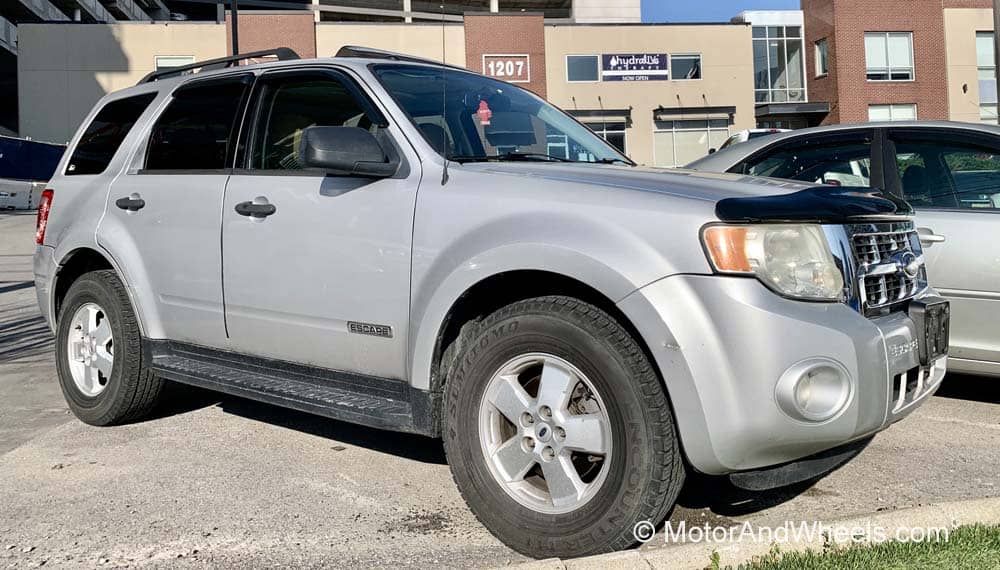
Ford’s popular compact SUV offering, the Escape, has enough design cues to satisfy your need for individuality and enough space to handle family transportation duties.
It also offers improved fuel economy, thanks to the addition of a hybrid model in 2020.
Fuel economy is perhaps the Escape’s biggest claim to fame.
Per estimates, the Escape returns an impressive 44 mpg on city roads and 37 mpg on the highway. This makes it good for use as a daily driver.
The Ford Escape has available cruise control models in the lineup.
Hence, you can control the speed of your vehicle without hitting any other vehicles on the road.
Electric cars with cruise control
We made a separate article about electric cars with cruise control .
Check the link above to read more about these great electric cars.
Click to share...
I tried adaptive cruise control on these EVs — and it changed the way I drive
Drivers may be surprised trying it out for the first time
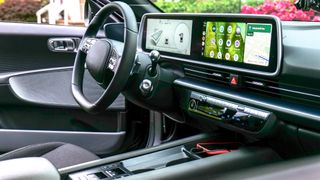
Three EVs and one PHEV in, there’s one feature I’ve been constantly leaning on my quest to drive the best electric cars around. It’s adaptive cruise control (ACC), which is also commonly referred to as dynamic cruise control and smart cruise control depending on the car maker. They all basically follow the premise of maintaining your vehicle’s speed while driving, but with the ability to steer the wheel for you as well so that you stay centered in your lane.
I can’t tell you how it’s the single thing that’s changing my habits, which I explained in detail when I test drove the Lexus TX550H+ and let it take over the wheel for me . This feature isn’t just exclusive to EVs because it’s been in many gas-powered vehicles and hybrids for a long while now, leveraging different technologies, such as LiDAR, sonar, radar, and even the cameras around the car.
For those still driving much older vehicles, say 10+ years old, they could find the experience of using adaptive cruise control a bit jarring when they upgrade — which could dissuade them from using it entirely. After driving multiple EVs with adaptive cruise control, I realize it serves its purpose more often than not. Here’s when you should and shouldn’t use it.
Perfect for highways
Cruise control has always been a driver’s best friend for those long trips on highways. Adaptive cruise control makes it even better because today’s vehicles can intelligently identify other moving vehicles — especially the one right in front of you.
When I test drove the Hyundai Ioniq 6 for a week , I was impressed by its ability to distance itself from the car in front of me while driving the speed limit on highways. When it senses it’s getting too close to the vehicle in front of me, or when an adjacent vehicle enters my lane, the Ioniq 6’s adaptive cruise control system automatically applies the appropriate amount of braking.
Even when the highway’s making a bend further up in the road, the Ioniq 6’s driver assist mode moves the steering wheel accordingly for me — all while maintaining my lane and speed.
Even great when switching lanes
@tomsguide ♬ Lofi Vibes - Gentle State
Taking things to the next level, I was astounded by the lane change assist feature while test driving the Kia EV9. My colleague Kate Kozuch also tried this helpful driving feature out when she test drove the Mustang Mach-E GT very recently, which performed a lane change on its own thanks to Ford’s BlueCruise self-driving technology .
Sign up to get the BEST of Tom's Guide direct to your inbox.
Get instant access to breaking news, the hottest reviews, great deals and helpful tips.
I tried out a similar lane changing assist feature with the Kia EV9 , and when paired with adaptive cruise control, I’m impressed by how it makes driving even easier (and safer too). Again, I think it works well on highways when you want to change lanes because adaptive cruise control continues to maintain the car’s speed — while also detecting other vehicles while it’s making a lane change.
Less burden with congestion driving

During my commute back home from New York City, congestion on the roads eventually brought traffic on the highway to its usual stop-and-go flow. With adaptive cruise control and driver assist enabled on the Kia EV9, it’s the perfect pairing for congestion driving on the highway.
That’s because the EV9’s able to apply the appropriate amount of braking and acceleration to keep its distance with the vehicle in front of me. Gridlock traffic is already a burden for all drivers on the road, but I love how this makes it less of a hassle. Even when the vehicle in front of me comes to a complete stop, adaptive cruise control automatically gets the vehicle moving once it clears up.
Although, I always kept my foot lighting over the brake because you just never know . I recommend that you do the same when using adaptive cruise control because it's the fail-safe method to instantly give back complete control of your vehicle.
Tough on local roads with faint lines

Now, one of the times I found it challenging to use adaptive cruise control was on city streets with faintly painted lines on the road. That’s because both the Ioniq 6 and EV9 struggled to keep their respective driver assist modes on to keep me centered in the lane. I’m able to recognize this because the dashboard display would normally show green lines alongside the car to indicate that it can stay centered in the lane.
Of course, it would go green whenever it can reestablish those lines on the road, but I wouldn’t lean on adaptive cruise control a whole lot when they’re indistinct.
Winding roads are troublesome

And finally, I would absolutely tell you to disengage adaptive cruise control on those long, winding roads that have you hitting steep inclines and tight turns. One of the challenges I encountered while driving with it on winding roads is that it wants to maintain the vehicle’s rate.
Naturally, this works wonderfully on straightaways and such, but it’s jarring when it encounters an incline because adaptive cruise control lacks human perception to anticipate road changes. For example, I found adaptive cruise control accelerating a little after going up a hill to maintain its speed — rather than anticipating the incline and accelerating beforehand to help sustain the vehicle’s momentum.
Furthermore, tight turns are nearly impossible for adaptive cruise control because it doesn’t adjust the vehicle’s speed ahead of time. It’s jarring when it’s cruising at 35 mph and wants to take a bend in the road at the same speed, rather than dialing down as the speed limit sign suggests.
While it’s not perfect for all driving conditions, I still find more benefits with using adaptive cruise control. Even though some parts of the technology help to propel fully automated vehicles, I need to remind everyone using this that it’s still an assistive feature — so it’s not meant to replace you entirely as the driver.
More from Tom's Guide
- I tried charging an EV at home and it was a shock I wasn't expecting
- Netflix and charge? Google Cast support coming to EVs
- Electric cars with the longest range
John’s a senior editor covering phones for Tom’s Guide. He’s no stranger in this area having covered mobile phones and gadgets since 2008 when he started his career. On top of his editor duties, he’s a seasoned videographer being in front and behind the camera producing YouTube videos. Previously, he held editor roles with PhoneArena, Android Authority, Digital Trends, and SPY. Outside of tech, he enjoys producing mini documentaries and fun social clips for small businesses, enjoying the beach life at the Jersey Shore, and recently becoming a first time homeowner.
I drove a Hyundai Ioniq 5 N for a week — and it’s a beast of an EV
I tried charging an EV with a portable power station — and the results surprised me
Labor Day apparel sales live blog — I'm a deals editor and here's the best discounts at Skechers, J.Crew, Nike and more
Most Popular
- 2 I've been covering Labor Day sales for 17 years — here's the best deals right now
- 3 Labor Day apparel sales live blog — I'm a deals editor and here's the best discounts at Skechers, J.Crew, Nike and more
- 4 Want the Saatva Classic but don’t have the budget? Try these Labor Day sales instead
- 5 Found them! The 5 cheapest mattress deals for dorms and guest rooms this Labor Day

COMMENTS
Adaptive cruise control (ACC) is a system designed to help road vehicles maintain a safe following distance and stay within the speed limit. This system adjusts a car's speed automatically so ...
Adaptive cruise control by the Insurance Institute for Highway Safety (example video) Adaptive cruise control ( ACC) is a type of advanced driver-assistance system for road vehicles that automatically adjusts the vehicle speed to maintain a safe distance from vehicles ahead. As of 2019, it is also called by 20 unique names that describe that ...
Updated May 9, 2022. Adaptive cruise control (ACC) is like traditional cruise control, but smarter. ACC systems allow you to set a desired speed until your vehicle encounters slower-moving traffic ...
Adaptive cruise control (ACC) is like regular cruise control but with a brain. Instead of maintaining a constant speed, ACC adjusts your car's speed based on the traffic ahead. Radar and cameras can slow down your car if it detects a slower vehicle in front and speed up again when the road is clear. Think of it as cruise control on steroids.
2. 2018 Mazda 3. The 2018 Mazda 3 provides drivers with an adaptive cruise control system that detects rear-cross traffic and blind-spot monitoring, great for making safe lane changes. It also ...
Cruise control is still the more prolific of speed controls offered on today's new cars, but adaptive cruise control has started gaining ground. More car models provide it as standard or as an ...
Adaptive cruise control as of 2013 ranges from $2,500 at the high end to as little as $500. Less costly "partial ACC" only works at speeds of 20 or 25 mph and up, but it's markedly cheaper.
Adaptive cruise control (ACC) is similar to standard cruise control in that it maintains a driver's preset speed once engaged. But unlike basic cruise control, ACC also automatically adjusts a car ...
Adaptive Cruise Control (ACC) is an intelligent driver assistance feature that works as an enhancement to traditional cruise control. Using a system of advanced sensors such as radar and cameras, ACC determines the speed and conditions of surrounding traffic and automatically adjusts cruising speed to maintain a safe distance within the flow of traffic.
Adaptive cruise control takes it to the next level. It maintains a set speed for your vehicle, like a conventional cruise control system, but it also adjusts the speed based on the traffic flow ...
Adaptive cruise control (ACC) is an active safety system that automatically controls the acceleration and braking of a vehicle. It is activated through a button on the steering wheel and cancelled by driver's braking and/or another button. Even the biggest car enthusiasts have journeys they wish to be chauffeured through, or at least ...
The first adaptive cruise control (ACC) system appeared in Japan in the early 1990s, although the first systems simply warned the driver of slower traffic ahead, and didn't control the car's ...
Like regular cruise control, adaptive cruise control (ACC) helps a vehicle maintain a safe speed set by the driver. However, it's not just a setting that keeps your car at 78-mph going down the highway. Instead, it's an entire system designed to help vehicles maintain a specific speed and a safe distance from others on the road.
Adaptive cruise control (often abbreviated to ACC) is a more advanced cruise control system that uses lasers, cameras or radar mounted in the front bumper to track the speed and position of the ...
By Scott Hinderer 04/19/2023 12:04pm. Adaptive cruise control is an advanced form of cruise control that can increase or slow vehicle speeds to maintain a programmed distance from the car ahead ...
Adaptive cruise control uses radar, lasers, cameras, or a combination of any of those items to calculate your surroundings. Its sensors and processors judge what the car in front of you is doing and regulate your car in relation to the one in front of you to maintain a safe distance, braking when they slow down and accelerating when they do, up ...
Adaptive Cruise Control is an advanced driver assistance feature that automatically adjusts your vehicle's speed to maintain a safe distance from the vehicle in front. Unlike traditional cruise control that maintains a constant speed, ACC can speed up or slow down based on the flow of traffic.
Adaptive cruise control started showing up in cars at the turn of the millennium and maintains a selected speed but also uses sensors to detect the vehicle in front of you. There are usually ...
Adaptive cruise control (ACC) is an enhancement of conventional cruise control. ACC automatically adjusts the speed of your car to match the speed of the car in front of you. If the car ahead slows down, ACC can automatically match it. Once the car ahead moves out of your lane or accelerates beyond your car's set speed, your ACC allows your ...
Adaptive cruise control (ACC) is an intelligent form of cruise control that allows vehicles to speed up and slow down automatically in order to keep pace with the traffic ahead. ACC is also known as autonomous cruise control, active cruise control, intelligent cruise control and radar cruise control. But regardless of what it's called, it's ...
5. Toyota RAV4. The Toyota RAV4 is a bestselling SUV that offers top-notch safety and luxury features. In particular, RAV4 buyers can get adaptive cruise control as optional equipment. The RAV4's ACC system uses radar sensors to help the vehicle maintain a safe distance from other vehicles.
1. To turn the feature on, press the cruise control On/Off button on the steering wheel. Your vehicle will default to the type of cruise control you last used when you turned your vehicle off. When the system is turned on, you'll see a white Adaptive Cruise Control icon in your cluster display or on your Head-Up Display, if your vehicle has ...
The Cooperative Adaptive Cruise Control (CACC) is an extension to the adaptive cruise control (ACC) concept using Vehicle-to-Everything (V2X) communication. CACC realises longitudinal automated vehicle control. In addition to the feedback loop used in the ACC, which uses Radar, Camera and/or LIDAR measurements to derive the range to the vehicle in front, the preceding vehicle's acceleration is ...
With adaptive cruise control and driver assist enabled on the Kia EV9, it's the perfect pairing for congestion driving on the highway. That's because the EV9's able to apply the appropriate ...
An adaptive cruise control method based on improved variable time headway strategy and particle swarm optimization algorithm. IEEE Access 2020; 8: 168333-168343. Crossref. Google Scholar. 12. Wang J, Rajamani R. Should adaptive cruise-control systems be designed to maintain a constant time gap between vehicles?